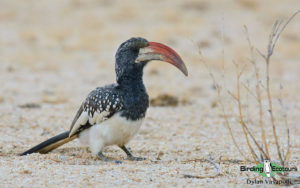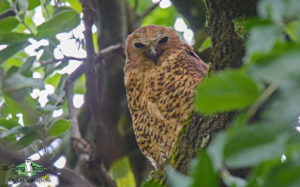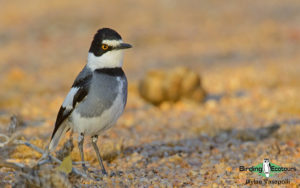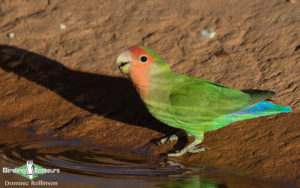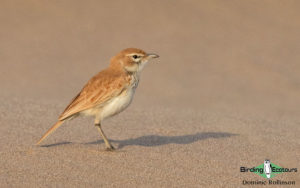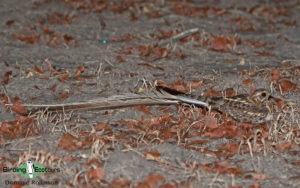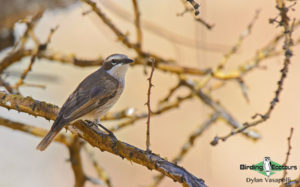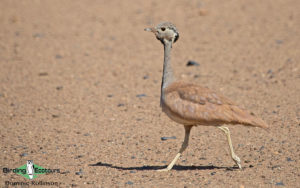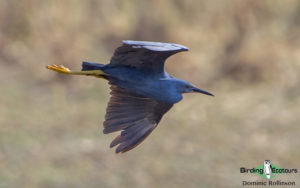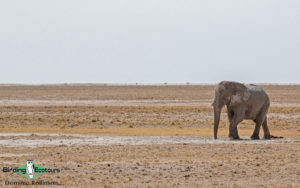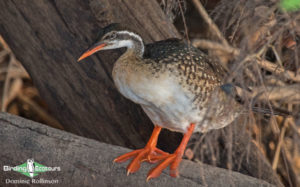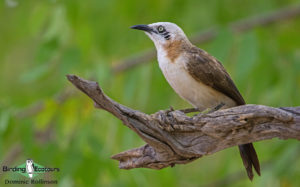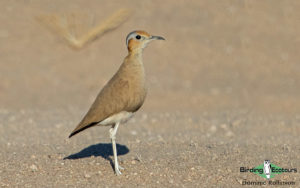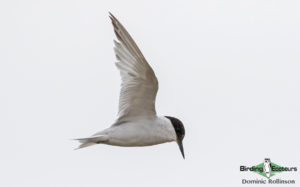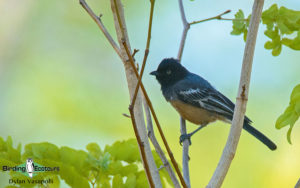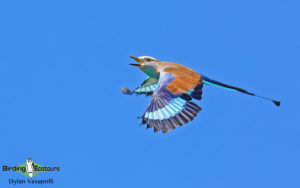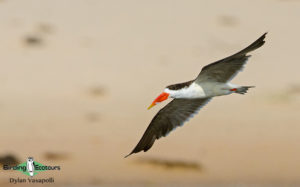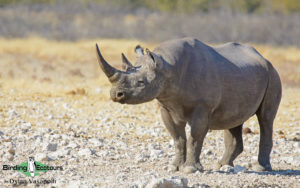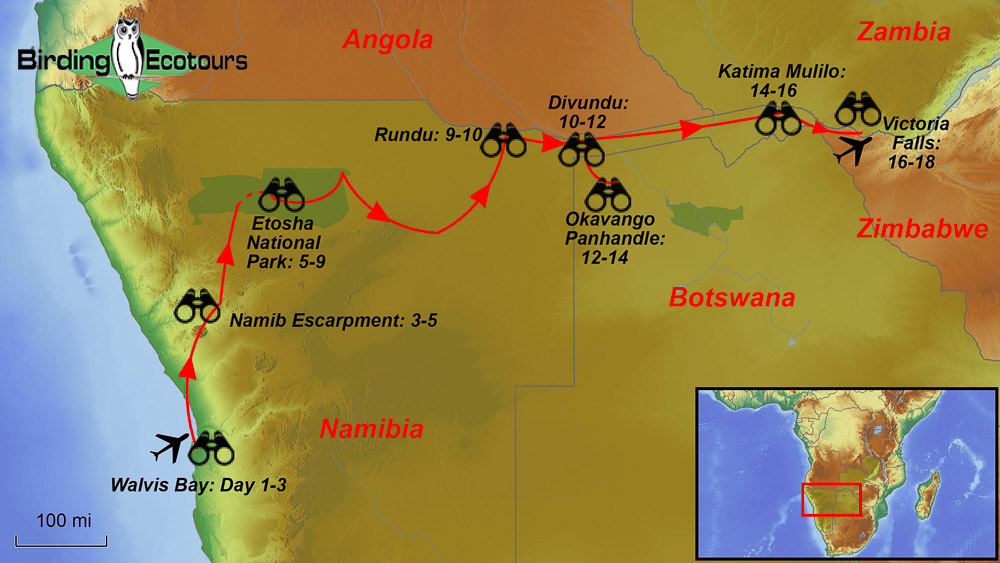Namibia, Okavango, and Victoria Falls Birding Adventure
Namibia, Okavango and Victoria Falls Birding Adventure
November 2025/2026
This is a truly marvelous 2.5-week birding adventure, during which we sample three different countries and spectacular, diverse scenery. We start in the coastal Namib Desert with its impressive dune fields (inhabited by some desirable, localized near-endemics) and lagoons filled with flamingos, pelicans, shorebirds, and some really localized species such as Damara Tern and Chestnut-banded Plover. The mountains of the beautiful Namib Escarpment are next on our itinerary, and here we search for Rosy-faced Lovebird, Herero Chat, Rockrunner, Monteiro’s Hornbill, Damara Red-billed Hornbill, the incomparable, batis-like (although largely terrestrial) White-tailed Shrike, and other charismatic species of northern Namibia.
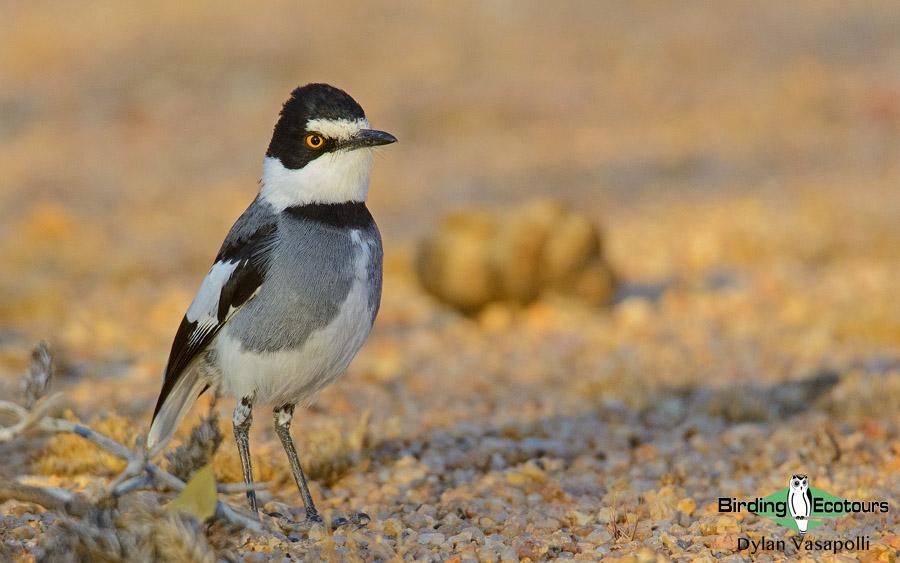
Eventually we leave the desert and enter the grassland, savanna, and woodland of one of Africa’s greatest game parks, Etosha National Park. This must surely be one of the world’s best places for seeing Black Rhinoceros and big cats, along with all the other African megafauna. It is also excellent for a good range of very special birds, such as Namibia’s dazzling national bird, Crimson-breasted Shrike, the world’s heaviest flying bird, Kori Bustard, the diminutive Pygmy Falcon, and stacks more.
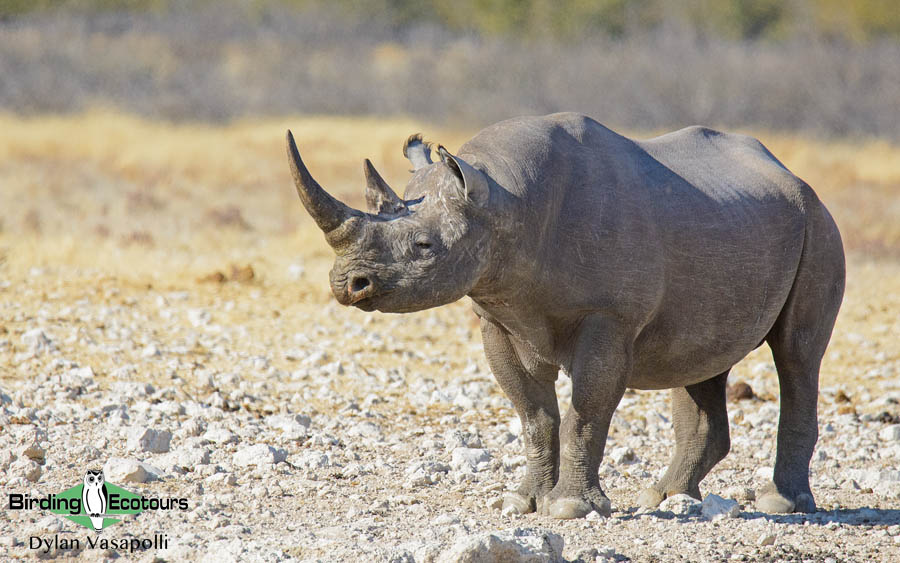
After Etosha we head into an incredibly bird-diverse tropical corner of Namibia, the Kavango East and Zambezi Regions (formerly the Caprivi Strip), and the adjacent panhandle of the Okavango Delta, which falls just within the borders of Botswana. The magnificent wetlands and woodlands in these parts support Pel’s Fishing Owl (this is the world’s most reliable place for this monster), White-backed Night Heron, Slaty Egret, Southern Carmine Bee-eater, and literally hundreds of other species, a rather large proportion of them spectacular. Finally, we bird around the impressive Victoria Falls for yet another rich assemblage of birds.
This birding tour covers a vast area and a huge range of habitats, from the coastal deserts to the land of big rivers. While Namibian distances are large, we minimize driving time and maximize birding time by starting in Walvis Bay, Namibia, and ending in Victoria Falls, Zimbabwe.
This tour can be combined with our premium Comprehensive Subtropical/Eastern South Africa Birding Tour which precedes this tour, for a 35-day Southern African adventure and even, preceding that, our Best of Cape Town and Beyond Birding Tour for an even longer, 42-day Southern African mega tour. Another possibility is to combine it with our Best of Madagascar: 14-day Birding and Wildlife tour.
Itinerary (18 days, 17 nights)
Day 1. Arrival in Walvis Bay and coastal desert birding
Our birding guide fetches you from Walvis Bay airport, and we immediately start birding. The first site we usually visit is the picturesque red sand dune habitat across a (usually) dry riverbed around the village of Rooibank, right in the middle of the Namib Desert. A Namibian near-endemic, Dune Lark (formerly a Namibian endemic until it was lumped with Barlow’s Lark which also occurs in South Africa), is the main target here, but we often also find the almost pure-white desert form of Tractrac Chat. Our accommodation for two nights is at a place where one can sometimes literally see thousands of flamingos (usually about half-half Greater and Lesser Flamingos), migratory shorebirds from Eurasia, Great White Pelican, and all the rest.
Overnight: Walvis Bay
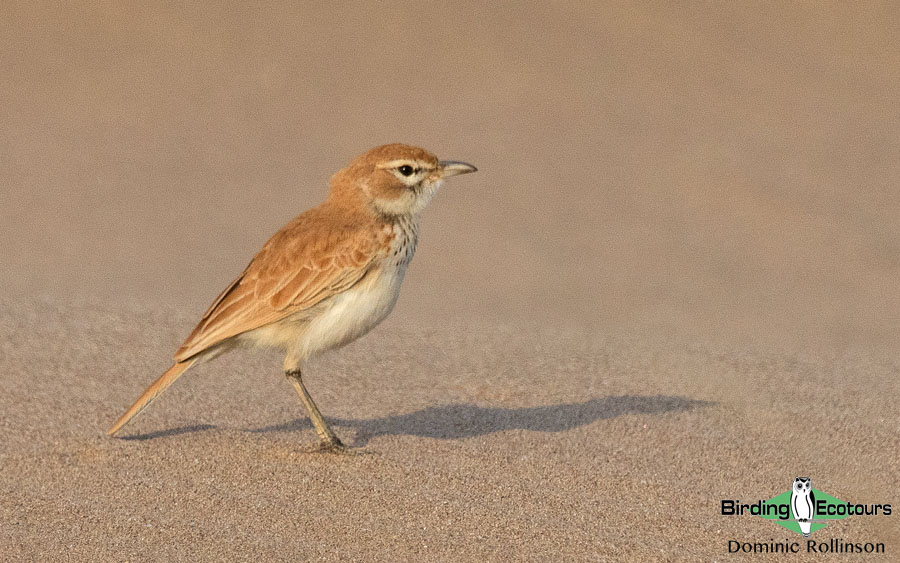
Day 2. Walvis Bay Lagoon, Swakopmund, and other areas
We will likely spend the early morning either looking for Dune Lark nearby (depending on the previous day’s itinerary) or for Gray’s Lark, a very pale Namib Desert near-endemic, in the Swakopmund area. We will then spend much time birding the Walvis Bay Lagoon and salt works which has some of Africa’s finest wader watching/shorebirding, with masses of Palearctic migrants usually around. Among our waterbird targets, will be Chestnut-banded Plover, Black-necked Grebe, Black Tern and the diminutive Damara Tern.
Overnight: Walvis Bay
Day 3. The Namib Escarpment via the Spitzkoppe (the “Matterhorn of Namibia”)
Heading inland and northward we start encountering some spectacular mountains. The Spitzkoppe in particular is a huge inselberg that rises abruptly from the desert plain. The flat surrounding areas are good for Burchell’s Courser, Rüppell’s Korhaan, Ludwig’s Bustard, a number of localized lark species such as Karoo Long-billed Lark, etc. The mountains themselves are where we search for the enigmatic Herero Chat, noisy little flocks of Rosy-faced Lovebirds, a couple of hornbill species that are basically restricted to the Namib and adjacent arid habitats, Bradfield’s Swift, and many others.
The rocky areas near Omaruru offer some great habitat for watching hunting raptors, including Verreaux’s Eagle and African Hawk-Eagle as well as Augur Buzzard. A diminutive antelope, Kirk’s Dik-dik, is often encountered in the area.
Overnight: Ai-Aiba – The Rock Painting Lodge, Omaruru
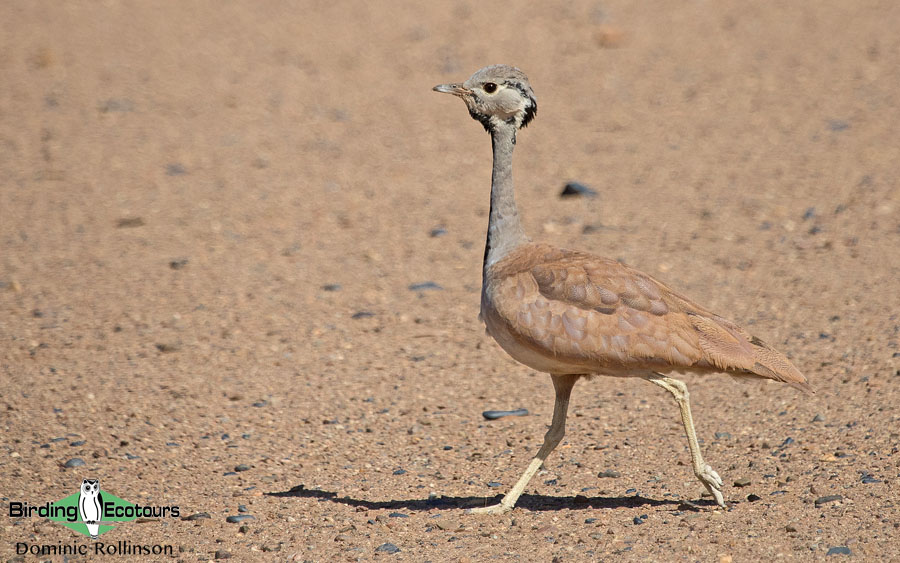
Day 4. Birding the Namib Escarpment
Today we have the full day to continue birding the mountains of central Namibia. White-tailed Shrike, Hartlaub’s Spurfowl, Rüppell’s Parrot, and Rockrunner are four of the superstars of the show – all of them are very localized (occurring only in Namibia and a small part of Angola) and full of personality, not to mention striking-looking. Quite a number of brightly-colored seedeaters also vie for attention around the lodge.
We will likely bird a dry riverbed for another shot at Rüppell’s Parrot in the afternoon and then bird the general area. We might, if we’re lucky, also see Kaokoveld Slender Mongoose, Greater Kudu, Hartmann’s Mountain Zebra, or another mammal or two.
Overnight: Ai-Aiba – The Rock Painting Lodge, Omaruru
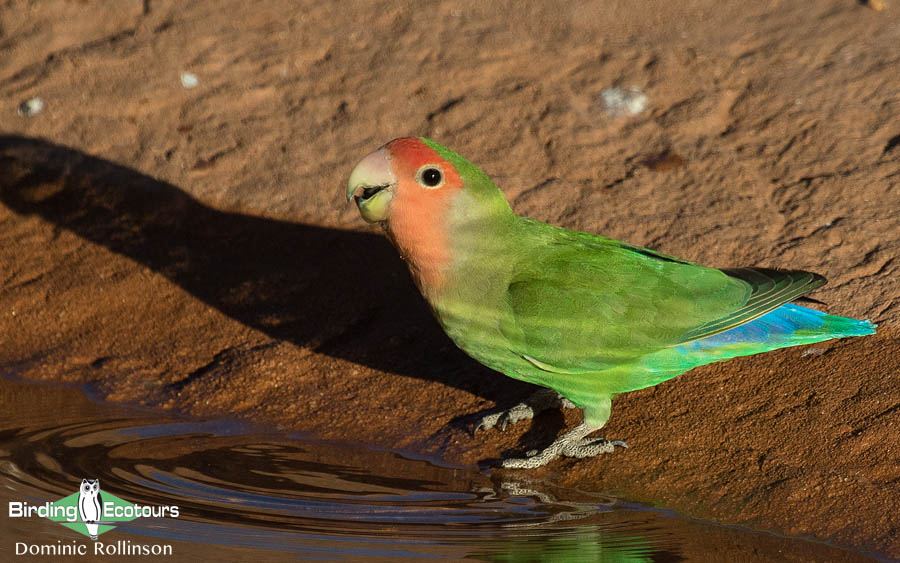
Day 5. Etosha National Park: birds and mammals
Etosha justifiably is rated as one of the best game parks in Africa. During our time in this amazing park, we will partake in an open-top game drive which is always a great way to experience the area’s birds and wildlife. This is big (and small) mammal country, where African Elephant, Black Rhinoceros, large herds of Springbok, Gemsbok, Plains Zebra, Blue Wildebeest, and many other herbivores lurk, meaning (excitingly) that there are also relatively high densities of predators and scavengers, such as Cheetah, Lion, Leopard, African Wildcat, Spotted Hyena, Black-backed Jackal, etc.
Although we stop to look at all the mammal species, birding is still the main focus. An isolated population of South Africa’s national bird, the beautiful Blue Crane, inhabits Etosha. Kori Bustard and its smaller relative, Northern Black Korhaan, are both common. Secretarybird and an absolute stack of raptors and vultures are always much in evidence. This is one of the best places in southern Africa for owls, and we often find the tiny African Scops Owl, the giant Verreaux’s Eagle-Owl, and then also others such as the beautiful Southern White-faced Owl at their daytime roosts (usually in Halali Camp, where we sometimes stop for lunch on one of the days). Etosha must be one of the few sites where one has to kick Double-banded Courser from one’s feet. The unbelievably huge nests of Sociable Weaver are features of some areas, sometimes with Pygmy Falcon taking up residence in the same nests.
Overnight: Okaukuejo Camp, central Etosha
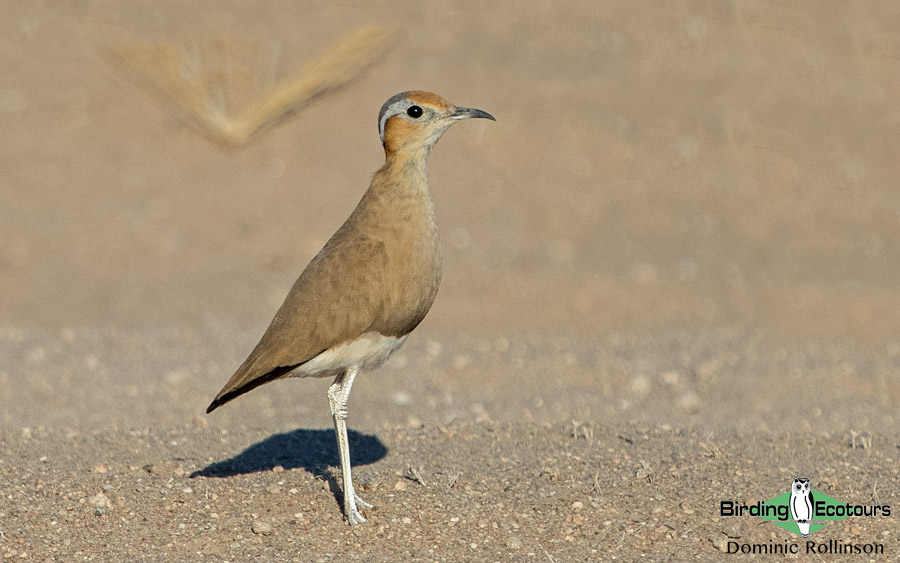
Day 6. Bird and wildlife viewing in Etosha National Park
We will have the full day in this impressive park birding the open plains and various waterholes. We hope to find a multitude of Lark species, including Eastern Clapper, Stark’s, Sabota, Pink-billed, Fawn-colored, and Rufous-naped, as well as larger and more brightly colored species such as Crimson-breasted Shrike, Gabar Goshawk, Greater Kestrel, Lappet-faced Vulture, and Namaqua Sandgrouse.
Overnight: Okaukuejo Camp, central Etosha
Day 7. Central to eastern Etosha National Park
Today we make our way from the central section of the park to the eastern edge. As we head farther east the bird species change gradually, and we hope to find Blue Crane, Secretarybird, Red-necked Falcon, Burchell’s Courser, and Caspian Plover among the usual suspects. Around Mokuti Lodge we should see Black-faced Babbler, Crimson-breasted Shrike, White-browed Scrub Robin, Black-faced Waxbill, Bearded Woodpecker, Pearl-spotted Owlet, and other woodland species.
Overnight: Namutoni Gate area, eastern Etosha
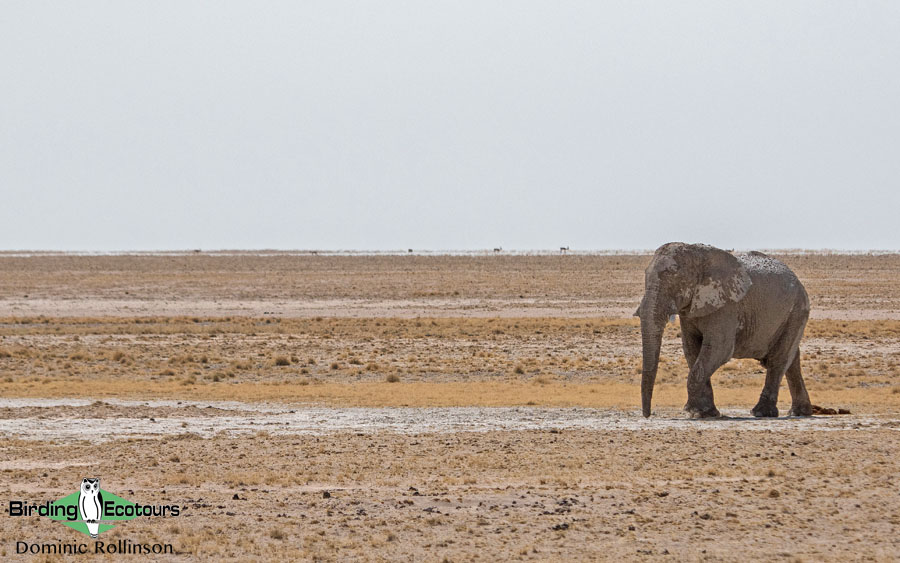
Day 8. Full day in eastern Etosha National Park
We will have the full day to enjoy the birds and wildlife of eastern Etosha today. We will likely head up to the grasslands of Andoni Plains to look for Blue Crane, Pink-billed Lark, Eastern Clapper Lark, and Burchell’s Courser, while also having some time to bird the woodlands around our lodge for Black-faced Babbler and many others.
Overnight: Namutoni Gate area, eastern Etosha
Day 9. Transfer to and birding around Rundu
As we continue eastward the landscape becomes less arid, and today we start seeing some well-developed woodlands for the first time during our tour. The tall woodlands east of Rundu are home to some tricky birds, such as Rufous-bellied Tit (which can be very thin on the ground and tough to find). Sharp-tailed Starling (along with the more common but also more spectacularly plumaged Greater Blue-eared Starling) and Souza’s Shrike are two tough birds of human-modified woodland sometimes in poor condition. There is a plethora of other great birds to be found here, both woodland birds and waterbirds, such as cuckooshrikes, orioles, Green-capped Eremomela, Tinkling Cisticola, Swamp Boubou, Dwarf Bittern, Rufous-bellied Heron, and a rich assemblage of others.
We will also bird the wetlands around Rundu for Collared Pratincole, White-backed Duck, Baillon’s Crake, Greater Painted-snipe, and perhaps even Lesser Moorhen and Lesser Jacana.
Overnight: Rundu area
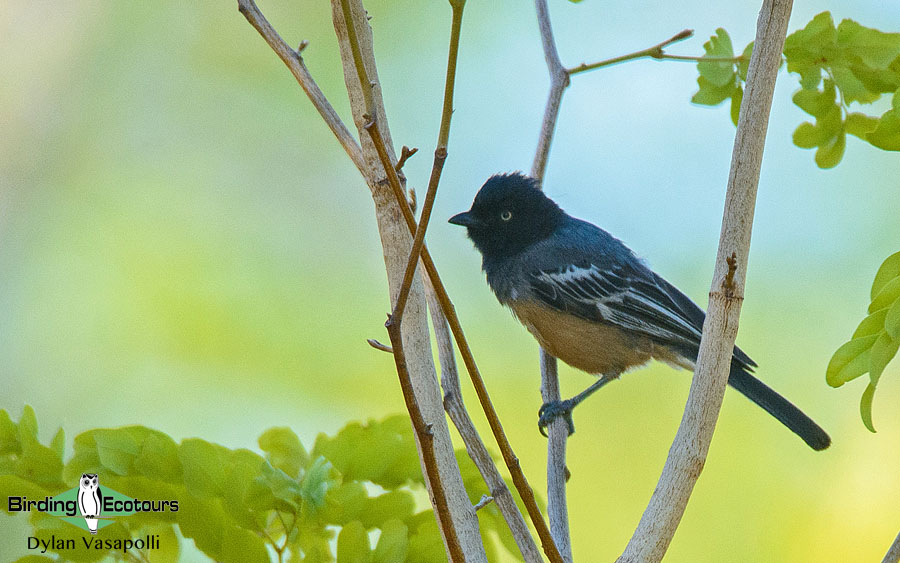
Day 10. Into northeastern Namibia
After some early-morning birding we will make the relatively short transfer to the Mahango area, which is incredibly biodiverse. We will have another shot at Souza’s Shrike, Sharp-tailed Starling, and Cinnamon-breasted Tit as we head east through the tall woodlands. We stay at a lodge near the tiny but impressively diverse Mahango Game Reserve, a protected area within Bwabwata National Park. Species to look for around the lodge include Meyer’s Parrot, White-breasted Cuckooshrike, African Golden Oriole, White-browed Robin-Chat, Brown Firefinch, and many others.
Overnight: Divundu area
Day 11. Mahango birding
We spend the day in the Mahango Game Reserve, enjoying birds such as Rock Pratincole and any of the birds mentioned for the previous day that we may have missed. Here we also add a great many new birds to our list, along with new mammals. African Buffalo occurs here but not in Etosha, and this is also one of the best places in the world to find the rare Roan Antelope and Sable Antelope. Wattled Crane, Slaty Egret, Western Banded Snake Eagle, Tinkling Cisticola, the oversized Coppery-tailed Coucal, several spectacular weavers with their bright yellow plumage and amazing nests, Greater Painted-snipe, and Grey-rumped Swallow are just a few of the many birds we’re likely to encounter at Mahango.
Overnight: Divundu area
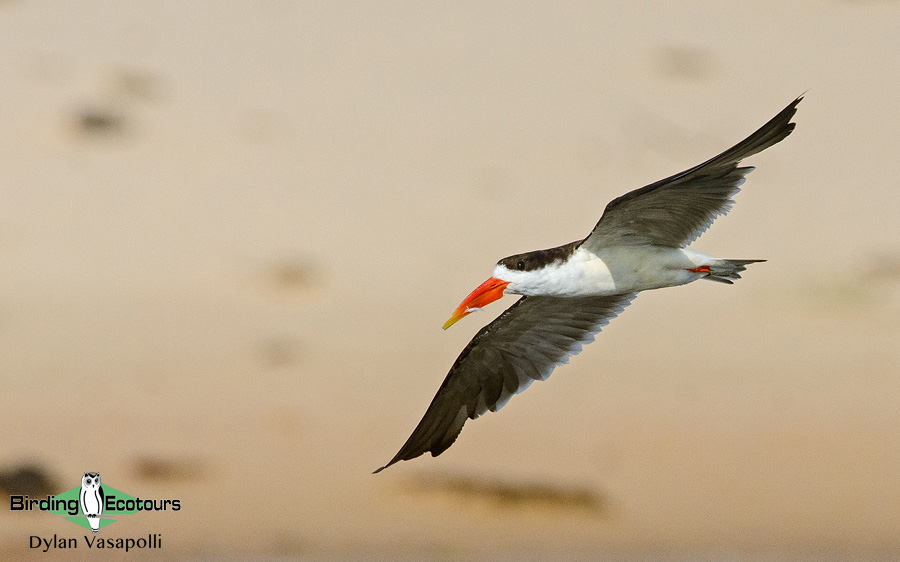
Day 12. Into Botswana: the Okavango Panhandle
The Botswana border is only a short drive away. After crossing it one immediately enters a more open, overgrazed habitat, which is, interestingly, the best place to see the localized Bradfield’s Hornbill. At Drotsky’s Cabins the loud grunts of Hippopotamus startle you as you fall asleep in your cabins; while in the water during the day, they do lurk around the lodge grounds at night eating grass – it’s not advisable to walk around after dark, as this is Africa’s most dangerous animal. The lodge grounds are a haven for birdlife, and we can expect to find Hartlaub’s Babbler, White-browed Coucal, and Meves’s Starling, with African Barred Owlet in the nearby woodlands. Brown Firefinch and its more common cousins, Red-billed Firefinch and Blue Waxbill, often feed on the lawns. The liquid calls of Swamp Boubou and coucals add greatly to the atmosphere.
Overnight: Drotsky’s Cabins, Shakawe, Botswana
Day 13. A full day in Botswana
We spend a lot of time birding by boat today as we slowly cruise the upper panhandle of the Okavango Delta. This day is usually excellent for photography, as we are able to approach many birds and animals really close from the boat, and highlights include Pel’s Fishing Owl, Slaty Egret, White-backed Night Heron, African Skimmer, African Pygmy Goose, Long-toed Lapwing, Coppery-tailed Coucal, and Southern Carmine Bee-eater. We may also be lucky enough to encounter the rare, swamp-dwelling Sitatunga antelope.
In the nearby woodlands we hope to find African Barred Owlet, Narina Trogon, Retz’s Helmetshrike, Grey-headed Kingfisher, African Golden Oriole, and Crested Francolin, among others.
Overnight: Drotsky’s Cabins, Shakawe, Botswana
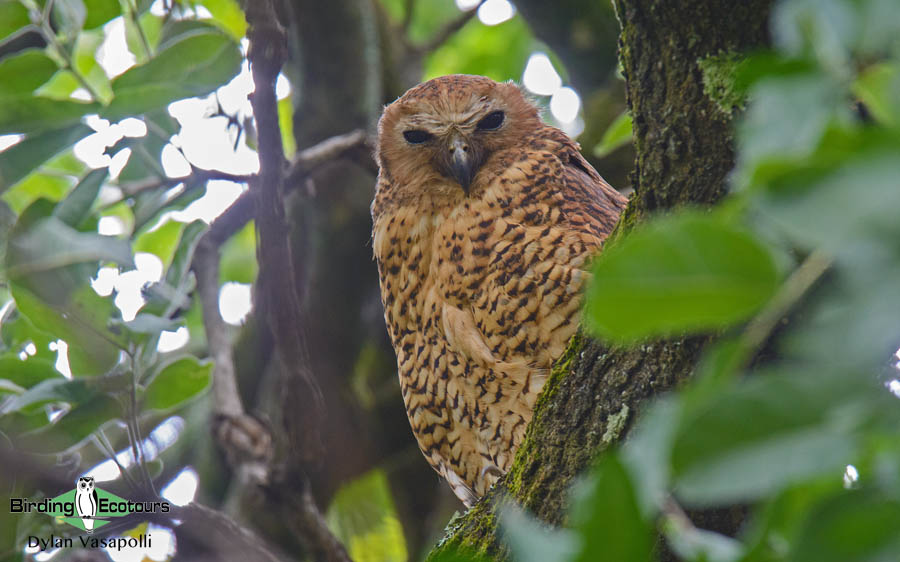
Day 14. Back into Namibia and continuing east
We continue birding the wetlands and woodlands of this bird-rich corner of Namibia. We spend two nights on the banks of the Zambezi River, from where we can do boat trips and birding/game drives. A late-afternoon boat trip along the Zambezi is extremely productive and usually produces great sightings of African Finfoot, White-backed Night Heron, Half-collared Kingfisher, White-crowned Lapwing, African Skimmer, and Rock Pratincole. We often head out this evening to look for night birds such as African Wood and Western Barn Owls and a host of Nightjars including Fiery-necked, Square-tailed, and the spectacular Pennant-winged!
Overnight: Katima Mulilo
Day 15. Birding around Katima Mulilo
Today we have the full day to explore the productive woodlands in the far-northeastern Namibia. Yellow-throated Leaflove was discovered as a breeding bird on the Namibia/Zambia border (the Namibian side) in 2015, hundreds of miles south of its previously known range, and is one of today’s targets. Olive Woodpecker, Schalow’s Turaco, and Western Banded Snake Eagle all occur in the riparian vegetation along the banks of the Zambezi River.
In the surrounding woodlands we search for Racket-tailed Roller, Arnot’s Chat, Copper Sunbird, Striped Kingfisher, Grey-headed Bushshrike, Grey Penduline Tit, Wood Pipit, and Lizard Buzzard.
Seasonal pans in the area are explored for Blue-billed Teal, Rosy-throated Longclaw, White-backed Duck, Lesser Jacana, Rufous-bellied Heron, Luapula Cisticola, and perhaps even Black Coucal.
Overnight: Katima Mulilo
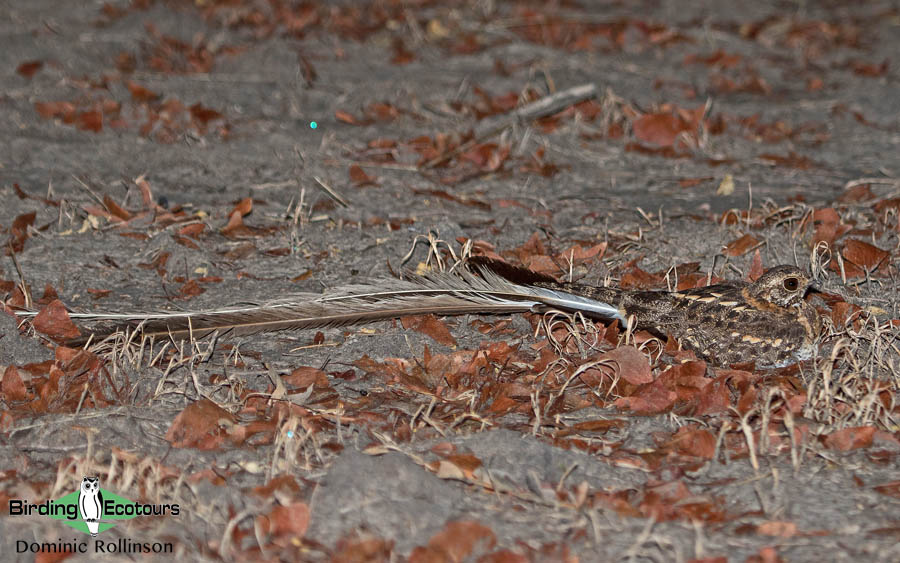
Days 16 – 17. Into Zimbabwe and birding Victoria Falls
After some final early morning birding around Katima Mulilo we transfer east, ultimately bound for Victoria Falls, in Zimbabwe. We have several border crossings to negotiate, and we anticipate reaching Victoria Falls only in the mid-afternoon of Day 16 – mostly a travel day. As we head further east we will pass through more broad-leafed woodland, occasionally seeing small roving groups of the scarce Southern Ground Hornbills on the roadside, but don’t expect much else on the transfer.
Once arrived and settled, we spend some time admiring Victoria Falls, ‘the smoke that thunders’, but it’s important to note that the whole area has spectacularly rich birdlife, so we’ll add a lot of good new birds to our list near the end of the tour. Birding around the busy town, along the grounds of our lodge, is extremely productive with regular sightings of Collared Palm Thrush, Natal Spurfowl, Bearded Scrub Robin, Schalow’s Turaco, Western Banded Snake Eagle, Trumpeter Hornbill, Olive Woodpecker, Broad-billed Roller, and other species along the Zambezi River.
We usually find close to 400 bird species on this tour of varied habitats – and we also get one of the highest mammal lists of any of our tours on this transect.
Overnight: Victoria Falls, Zimbabwe
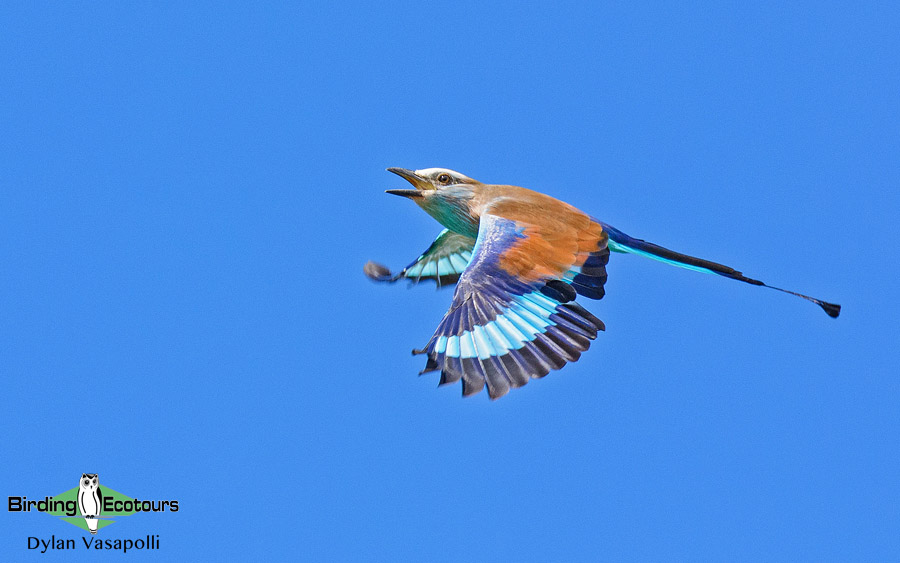
Day 18. Departure
The tour comes to an end after breakfast, and no activities are included today. You are welcome to depart Victoria Falls, Zimbabwe at your leisure.
Please note that the itinerary above cannot be guaranteed as it is only a rough guide and can be changed (usually slightly) due to factors such as availability of accommodation, updated information on the state of accommodation, roads, or birding sites, the discretion of the guides and other factors. In addition, we sometimes have to use a different international guide from the one advertised due to tour scheduling.
Download ItineraryNamibia, Botswana and Victoria Falls Trip Report
02 – 19 NOVEMBER 2024
By Dominic Rollinson
DOWNLOAD TRIP REPORT
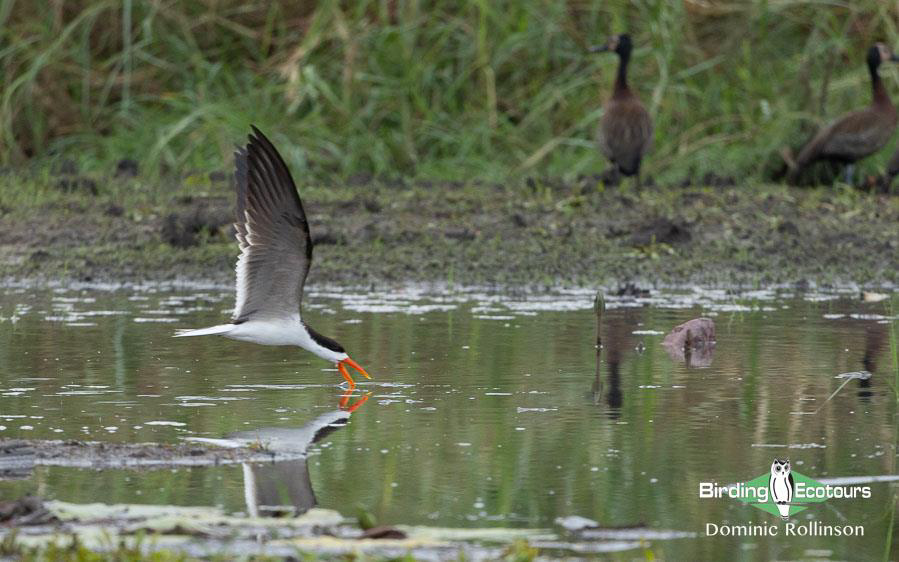
Watching African Skimmers skim-feeding was a sure trip highlight.
Overview
This southern African birding and wildlife safari covers the breadth of Namibia, taking in a large variety of habitats from the Namib Desert near Walvis Bay, in Namibia, to the subtropics of Victoria Falls, in Zimbabwe and Zambia. This diversity of habitats means we normally end up with an impressive bird list and this particular trip was no different and we happily recorded 396 bird species. Of course, it was not only about the quantity of species seen but also the quality, with many Namibian near-endemics and regional specials found. This is always an enjoyable and feel-good tour, with generally excellent infrastructure geared towards eco-tourism and high-quality accommodation (with tasty and varied meals) and easy access to areas with high diversities and abundances of birds and other wildlife.
Some of the standout bird species on this southern African birding tour included Pel’s Fishing Owl, Schalow’s Turaco, White-backed Night Heron, Lesser Jacana, Southern Carmine Bee-eater (at their breeding colony), Pennant-winged Nightjar, Racket-tailed Roller, Southern Ground Hornbill, Martial Eagle, Red-necked Falcon and Kori Bustard. While some of the near-endemics and regional specials included Slaty Egret, Rüppell’s Korhaan, Burchell’s Sandgrouse, Damara Red-billed and Monteiro’s Hornbills, Rüppell’s Parrot, Souza’s Shrike, Dune, Stark’s and Pink-billed Larks, Pale-throated Greenbul, White-tailed Shrike, Herero Chat, Rufous-eared Warbler, Sharp-tailed Starling and many others.
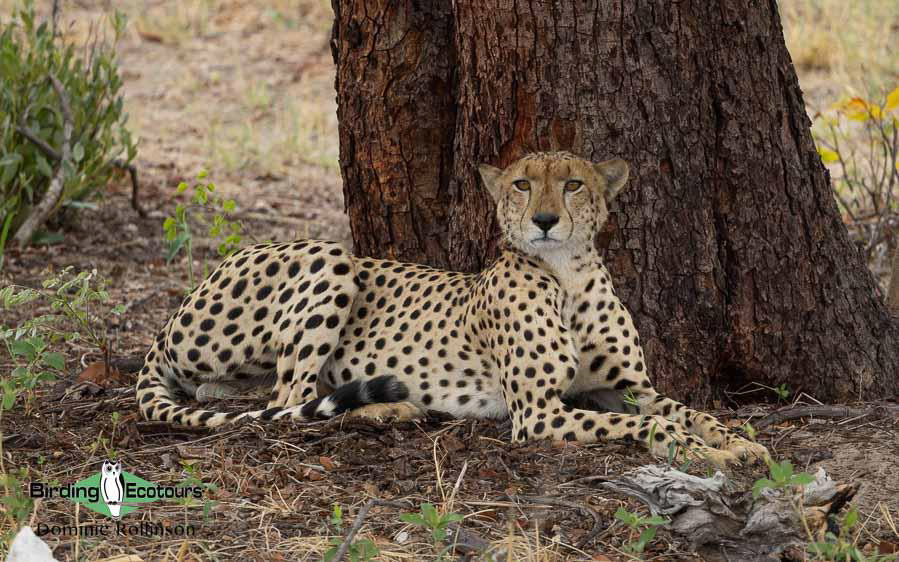
This Cheetah in Caprivi Game Park was a pleasant surprise.
As always, this tour included many fantastic sightings of large and charismatic megafauna including Lion, Cheetah, African Elephant, Black Rhinoceros, Common Hippopotamus, Spotted Hyena, Cape and Bat-eared Foxes, Angolan Slender (Black) Mongoose, Giraffe, and (Hartmann’s) Mountain Zebra. We recorded an impressive 49 species of mammals on this tour! A memorable predation event involving a Bushveld Sengi and Horned Adder was also certainly one of the highlights of the trip for many!
Detailed Report
Day 1, 2nd November 2024. Arrival and Walvis Bay birding
As some of the group had arrived the previous day in Namibia, we decided to make an early start and birded the Walvis Bay coast and salt works which, as always, proved highly productive with some lovely sightings of the masses of shorebirds which winter in the area. Some of the highlights included the likes of Common Ringed, Chestnut-banded and White-fronted Plovers, Sanderling, Curlew Sandpiper, Little Stint, Bar-tailed Godwit and the scarce Marsh Sandpiper. Terns were in high abundance too and we added Common, Sandwich, Greater Crested, Black and a single Arctic Tern. First prize, however, went to good looks at a single Damara Tern which is always high on the agenda at Walvis Bay. A single Osprey was a surprise, and we of course acquainted ourselves with the huge numbers of Greater and Lesser Flamingos and a few massive Great White Pelicans.
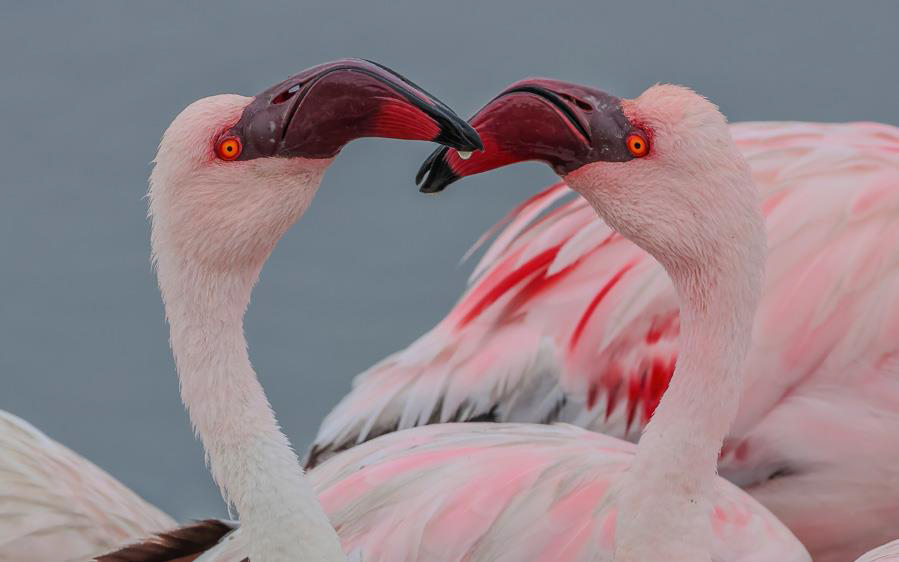
Lesser Flamingoes provided us with fantastic views in Walvis Bay (photo Nico Heyning).
After lunch I collected the last few tour participants, and we again enjoyed some more coastal birding in the late afternoon where we saw most of the common shorebirds listed above and further improved our looks at Damara Tern with a few close flybys. We finished the day enjoying our dinner while overlooking the bay with both Lesser and Greater Flamingos adding more color to the scene.
Day 2, 3rd November 2024. Walvis Bay boat cruise and birding
This morning we headed out before sunrise to nearby Rooibank, to some low red sand dunes along the edge of the dry Kuiseb River to look for Dune Lark. Unfortunately, on our way to the parking spot I managed to get us properly stuck in some very soft sand. About 90 minutes later, with many rocks, bricks and logs laid onto the sand track and with deflated tyres, we managed to get the van out and just about made it back to our accommodation in time for breakfast. We decided the procedure was a carefully planned team bonding activity! The Dune Lark would have to wait until later.
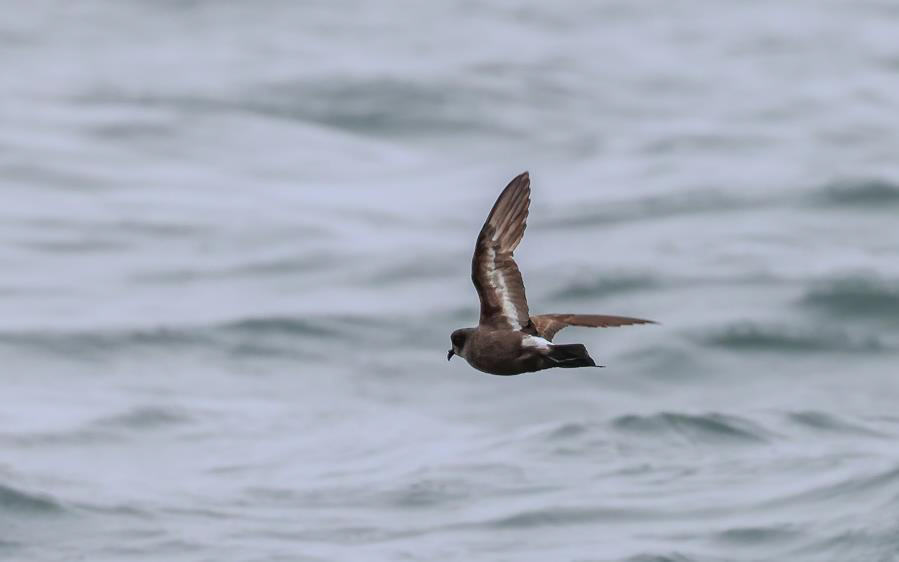
A European Storm Petrel showing its clear white underwing flash (photo Nico Heyning).
After a rushed breakfast back at our lodge, we headed out for our Walvis Bay boat cruise which is always an enjoyable way to spend the morning. While out on the water we had looks at Sooty Shearwater, White-chinned Petrel and an unexpected European Storm Petrel. We couldn’t have asked for better looks at the many massive Great White Pelicans and also enjoyed Afro-Australian Fur Seals cheekily hopping up onto our boat for a fish snack. We were excited to find a friendly group of Common Bottle-nosed Dolphins which kept us entertained with some impressive jumps clear out of the water while a group of around seven Humpback Whales also showed incredibly well. Masses of terns were seen (mostly Common Terns) with good numbers of Black, Sandwich, Caspian and Greater Crested Terns seen too. We finished the boat cruise with a tasty second breakfast spread, including oysters and champagne (for some).
Once back on dry land we picked up some lunch and made our way north through the picturesque town of Swakopmund which has some impressive German architecture. We stopped in the white sand plains north of town to look for Gray’s Lark, but despite a concerted effort the birds would not show at their normally reliable stakeout. We then made a quick detour on our way back to Walvis Bay to see the impressive Welwitschia mirabilis plant – a gymnosperm which is restricted to the Namib Desert of Namibia and Angola. We found examples of both male and female plants in the area and even managed to find a few Welwitschia Bugs which are suspected to play a role in the plant’s pollination. Amazingly, these plants are thought to often live to over 1,000 years old, sometimes as old as 2,000 years! In the area we also managed to find the pale Namib Desert form of Tractrac Chat.
After reuniting Ruth and Todd with their luggage at Walvis Bay airport, we headed back to Rooibank to have a proper attempt at finding Dune Lark. This species was, until recently, considered a Namibian endemic, however, with the lumping of Barlow’s Lark (which occurs across the border into South Africa), it means Namibia has lost its only bird endemic species. After ensuring we avoided the sand track, we set out into the low red sand dunes. The larks took a little longer than usual, however, we eventually enjoyed good looks of a singing bird in the lovely late-afternoon light. We then returned to Walvis Bay after an eventful and fun first full day of the tour.
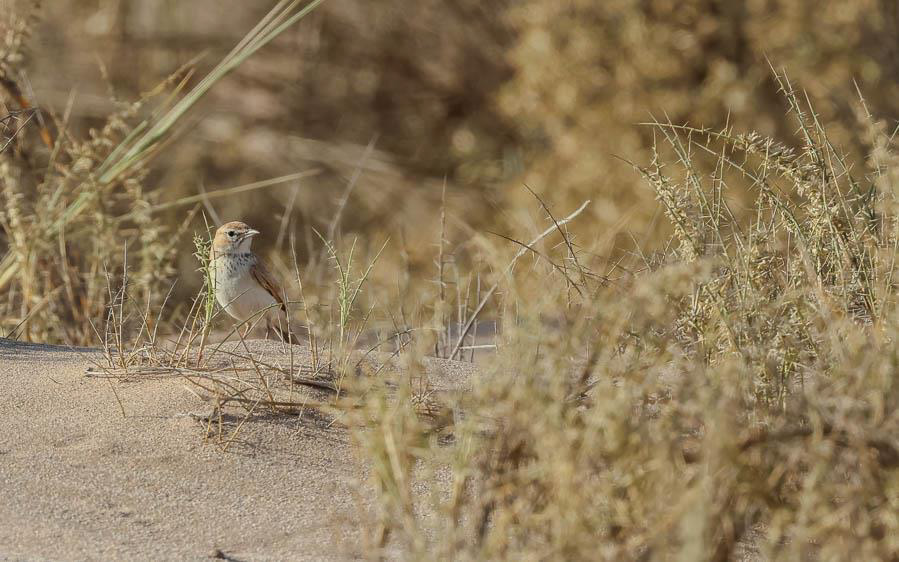
We eventually managed good views of Dune Lark near Walvis Bay (photo Nico Heyning).
Day 3, 4th November 2024. Walvis Bay to Erongo Mountains, Spitzkoppe birding en route
Today was an even earlier start as we wanted to get out into the Namib Desert before it heated up too much. After passing through Swakopmund we decided to have another go at Gray’s Lark which unfortunately again proved unsuccessful. Saying goodbye to the Atlantic Ocean, our destination was Spitzkoppe (meaning ‘sharp head’ in German) which is a group of granite inselbergs that rise out of the Namib Desert, reaching a height of 2,200 feet (670 meters) above the desert floor. Interestingly, the still photos used as backgrounds for the ‘Dawn of Man’ sequence in 2001: A Space Odyssey were from the Spitzkoppe Mountains! As we made our way through the Namib Desert, we were happy to find a small group of the near-endemic Rüppell’s Korhaan.
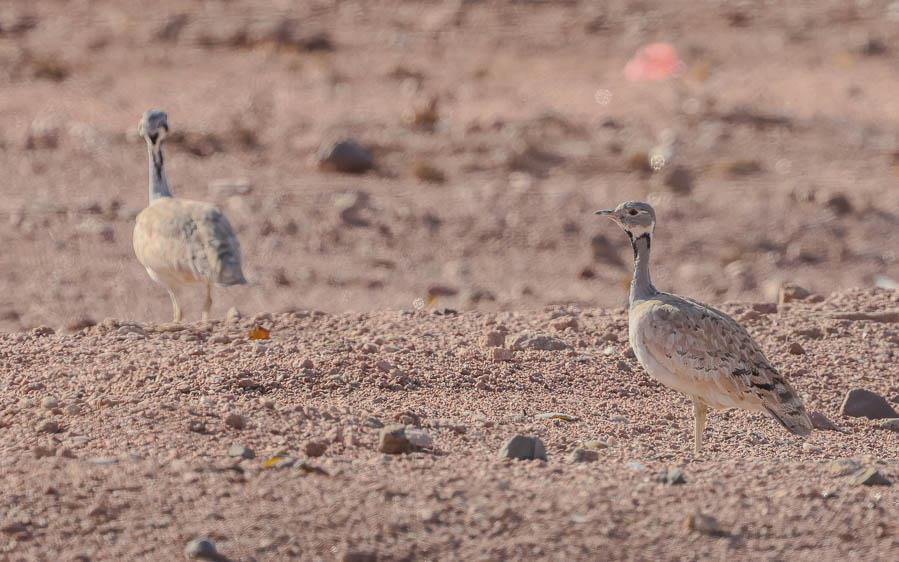
Rüppell’s Korhaan was seen well in the Namib Desert (photo Nico Heyning).
We weren’t only visiting Spitzkoppe to enjoy the dramatic beauty of the area though and immediately upon our arrival we saw our target, Herero Chat (another Namibian near endemic). This species can often require a large amount of time and effort and so we were relieved to find it before we had even hopped out the van. While we were enjoying the chat a Bushveld Sengi (elephant shrew) shot out of some nearby bushes and when we found it again a few meters away it seemed to be on its way to dying and passed away in front of our eyes, which left us all perplexed as to what had caused its demise!
Our short stint at Spitzkoppe proved to be very productive with other additions to the list including Mountain Chat, White-browed Sparrow-Weaver, Grey Go-away-bird, Gabar Goshawk, Black-chested Prinia, Chestnut-vented Warbler, Dusky Sunbird and White-throated Canary. As we got back to the van, Kay decided to have another look at the sengi and was excited to find that it was busy being devoured by a Horned Adder which we watched for the next ten minutes! We put two and two together and realized that the elephant shrew must have been bitten just before we saw it, with the adder tracking it down while we were away birding. Certainly, an early trip highlight!
We then took the long and bumpy road to the Erongo Mountains, arriving in the early afternoon for a late lunch and some time off during the sweltering heat. Once it had cooled down, we took a walk around the picturesque granite outcrops in the area where we unsuccessfully looked for Hartlaub’s Spurfowl and Rockrunner. We did, however, find Southern Grey-headed Sparrow, Long-billed Crombec, Swallow-tailed Bee-eater, Large Rock Martin and many Pale-winged Starlings.
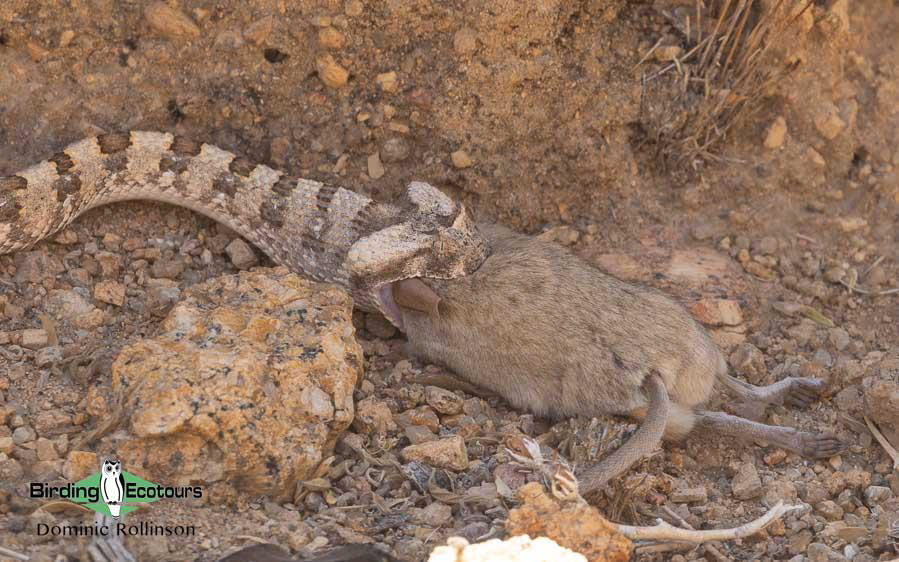
The Horned Adder slowly swallowing the Bushveld Sengi at Spitzkoppe.
Later that evening we enjoyed our checklist session while being distracted by calling Freckled Nightjars, some even perching on the roof of the restaurant.
Day 4, 5th November 2024. Erongo Mountains birding
We took advantage of the cooler temperatures in the early morning and met at sunrise and again continued our search for the spurfowl and Rockrunner in the granite koppies around our lodge. Yet again our efforts proved unsuccessful, however, we did find many other exciting species such as African Hawk-Eagle, African Grey Hornbill, Crimson-breasted Shrike, Marico Sunbird and Grey-backed Camaroptera. A young albino Rock Hyrax was an interesting observation, and we all wondered how long this highly visible creature would survive! Other new mammals included Chacma Baboon and a distant (Hartmann’s) Mountain Zebra.
After a late and impressive breakfast spread, we headed out for a short drive through the Erongo Conservancy. As it was already late morning, the mercury had already begun to rise, however, we did manage to find Monteiro’s Hornbill, Swallow-tailed Bee-eater, White-tailed Shrike, Pririt Batis, Marico Flycatcher, Kalahari Scrub Robin and Short-toed Rock Thrush. While on our drive we also encountered some large animals including South African Ground Squirrel, Springbok, Damara Dik-dik, Steenbok, Gemsbok, Greater Kudu and Giraffe.
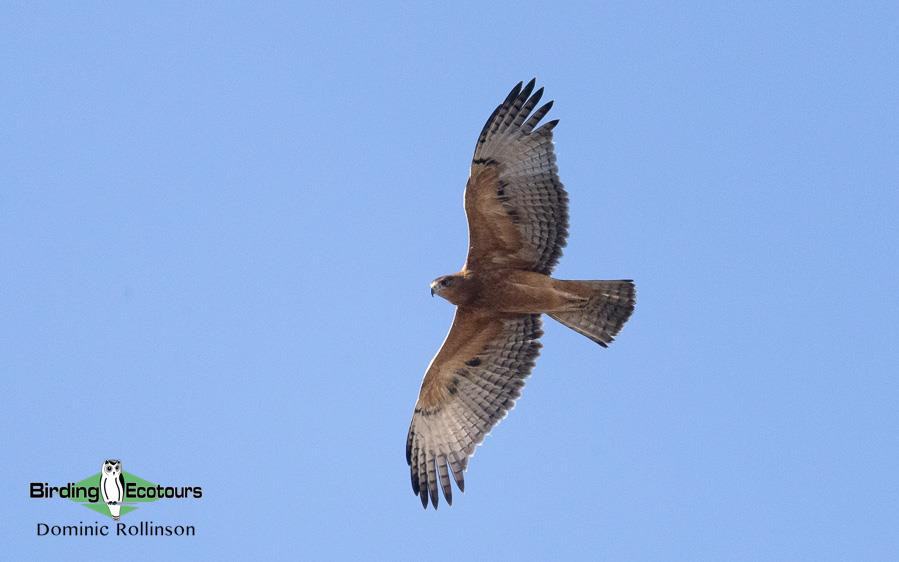
This juvenile African Hawk-Eagle provided good looks in the Erongo Mountains.
We then enjoyed a leisurely lunch and some downtime during the extreme midday heat. In the early afternoon we took a drive out to a nearby dry riverbed where we were after Rüppell’s Parrots which are frequently found feeding in the trees here. As hoped for, the parrots were again around today and we eventually enjoyed looks at yet another Namibia near endemic. Other interesting birds seen in the dry riverbed included African Hoopoe, Damara Red-billed Hornbill, White-tailed Shrike, Black-backed Puffback, Black-chested Prinia, Chestnut-vented Warbler, Cape Starling, Groundscraper Thrush and Kalahari Scrub Robin.
That evening, during dinner, we watched good numbers of Double-banded Sandgrouse coming in to drink at the waterhole once darkness had fallen, with several vocal Freckled Nightjars around too. After dinner, we decided to head out for a quick night drive through the Erongo Conservancy which proved rather productive, with highlights including African Savanna Hare, Southern African Springhare and several Damara Dik-diks.
Day 5, 6th November 2024. Erongo Mountains to Etosha National Park
We again birded around the lodge for the morning where we again concentrated on Hartlaub’s Spurfowl and Rockrunner. We eventually had to give up with the spurfowls after not hearing a peep from them, however, right at the last minute we managed to find a Rockrunner calling close to the lodge. Other bird species that kept us entertained during our walk included Grey Go-away-bird, African Hawk-Eagle, White-tailed Shrike, Pririt Batis, Yellow-bellied Eremomela, Short-toed Rock Thrush and Dusky Sunbird. After another scrumptious breakfast we loaded up the van and started making our way northwards to Etosha National Park.
The drive was a longish one and didn’t prove too eventful, however, we enjoyed our first sightings of Purple Roller (just north of Omaruru) as well as White-rumped Swift and Greater Striped Swallow.
We arrived in Etosha in the early afternoon and checked into our accommodation at Okaukuejo Camp (a former German fort built in 1901 – the watch tower is part of the remnants of the fort) and enjoyed some time off during the heat of the early afternoon. Later in the afternoon (when it should have cooled down a bit but had not) we enjoyed a drive east of camp along the edge of the massive and dry Etosha Pan. Highlights along this drive included many open plains birds such as Common Ostrich, Double-banded Sandgrouse, Kori Bustard, Red-crested and Northern Black Korhaans, Pale Chanting Goshawk, Cape Crow, Stark’s Lark, Chat Flycatcher and Great Sparrow. While waiting at Gemsbokvlakte waterhole we were entertained by Giraffe and Black Rhinoceros which came down to drink as well as a couple Black-backed Jackals – a lovely way to finish the afternoon.
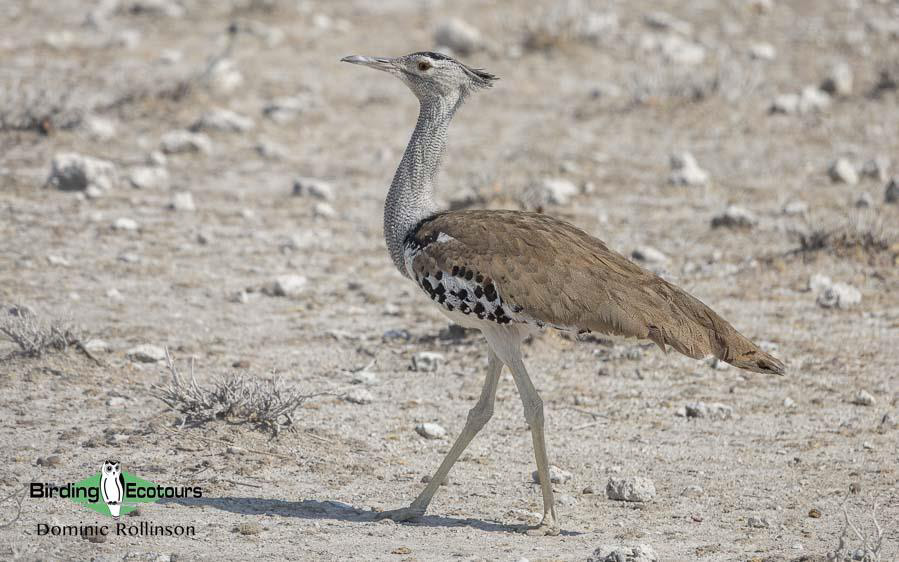
Kori Bustards are always plentiful in Etosha National Park.
Later that evening after dinner, we enjoyed some time at the waterhole (a definite highlight of camps in Etosha) where we found bathing Black Rhinoceroses as well as a few Rufous-cheeked Nightjars which were feeding on insects attracted by the floodlights. This particular waterhole must surely be the best publicly accessible spot to view Black Rhinoceros in all of Africa. Not only is it a reliable spot to see the rhinos but you can watch the animals, sometimes for hours on end, as they go about socializing, and even vocalizing!
Day 6, 7th November 2024. Central Etosha; birds and large game
This morning we enjoyed a private open-top game drive from Okaukuejo. We again made our way east of camp and enjoyed further great sightings. Avian highlights of the morning included African Grey Hornbill, European Bee-eater, Greater Kestrel, Red-necked Falcon, Rufous-naped, Stark’s and Red-capped Larks, Rufous-eared Warbler and Scaly-feathered Weaver. Some of our mammalian highlights included African Savanna Elephant, Black-backed Jackal, Banded Mongoose, Plains Zebra, Impala and Common Eland.
We got back into Okaukuejo in the late morning and decided to head out for a walk around the rest camp, which proved productive. It was good to stretch our legs after the morning in the vehicle and enjoyed the likes of Namaqua Dove, Little Grebe, Black-headed Heron, Purple Roller, Acacia Pied Barbet, Cardinal Woodpecker, Brubru, Crimson-breasted Shrike, Southern White-crowned Shrike, Spotted and Marico Flycatchers, Marico Sunbird, Sociable Weaver, Red-headed Finch, Shaft-tailed Whydah and Black-throated Canary. We ate lunch and then took some time off, before meeting up again in the late afternoon for another drive. The afternoon was a bit quieter, however, we did manage to find Namaqua Sandgrouse, Bateleur, Tawny Eagle, Red-necked Falcon, Grey-backed Sparrow-Lark, Spike-heeled, Stark’s and Pink-billed Larks and Ant-eating Chat. We searched for Pygmy Falcons which nest inside the many Sociable Weavers nests in the area but, despite a concerted effort, we could not find our primary target for the afternoon. After dinner, some of us again enjoyed looks at Black Rhinos at the waterhole.
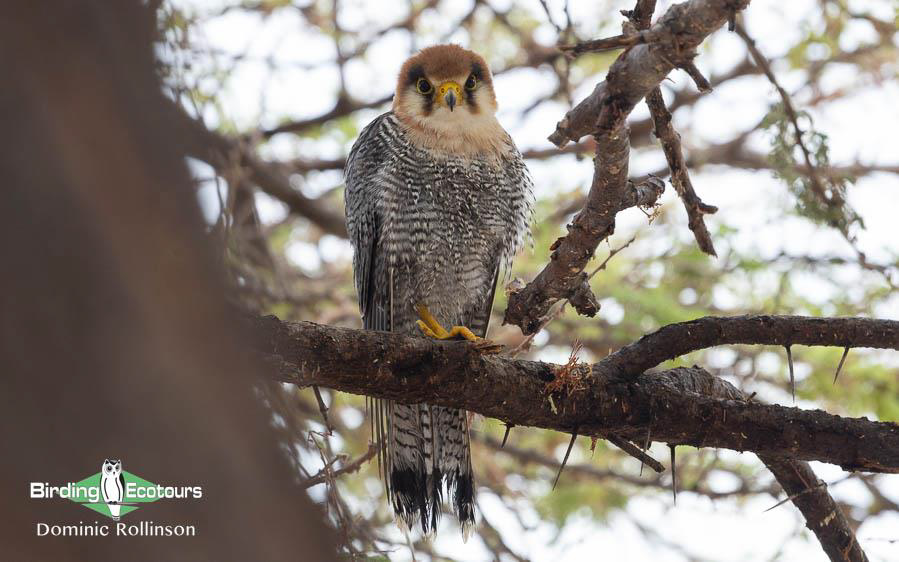
Red-necked Falcons are usually seen well in Etosha – this trip was no exception.
Day 7, 8th November 2024. Central to eastern Etosha; birds and large game
We had an early breakfast this morning as we had a long drive ahead of us, through the eastern half of Etosha. The drive was only about 100 miles (160 kilometers), however, it invariably takes most of the day because we travel at low speeds with many birding and wildlife stops en route. As we slowly made our way through the park, we continued to add new birds with some of the morning’s top birds including Lanner Falcon, Desert Cisticola and Red-breasted Swallow. It was, however, mammals that stole the show this morning with some incredible sightings of a single Cape Fox and a small family of Bat-eared Foxes.
In the late morning, we entered Halali Camp and immediately began our search for a few special bird targets. We were successful and soon found Bare-cheeked Babblers and Violet Wood Hoopoes which both showed very well for us. The camp is always very birdy and we managed to find Namaqua Dove, Southern Yellow-billed and Southern Red-billed Hornbills, White-crested Helmetshrike, Red-backed Shrike and Golden-breasted Bunting.
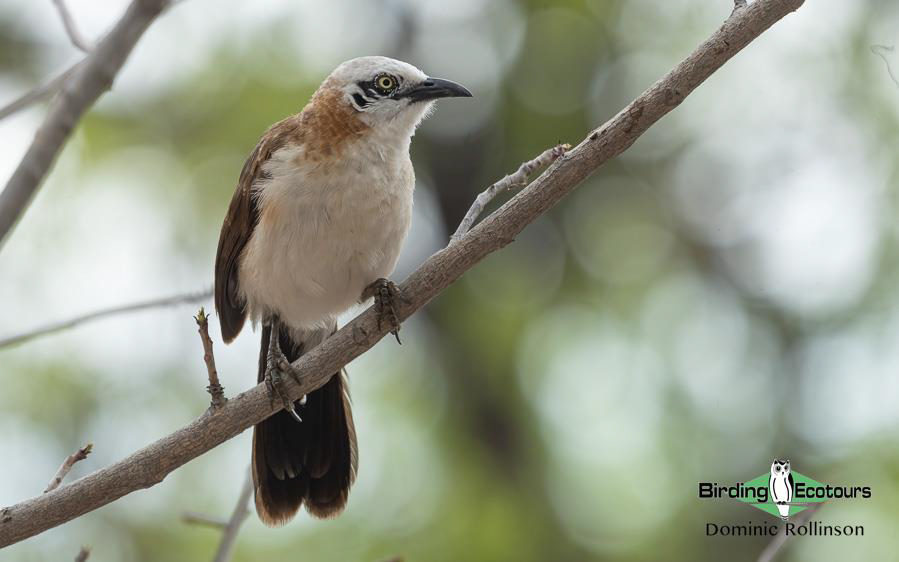
Halali Camp in Etosha is an excellent place to see Bare-cheeked Babbler.
Day 8, 9th November 2024. Eastern Etosha; birds and large animals
We had the exciting prospect of a full day in eastern Etosha today and, after an early breakfast, we made our way back into the park to Dik-dik Drive, near Namutoni Camp. Along this circular drive we added the likes of Black-faced Babbler (about the only area of Etosha where this species occurs), White-browed Scrub Robin, White-bellied Sunbird, Red-billed Quelea, Red-headed Finch, Violet-eared and Blue Waxbills, Green-winged Pytilia and Shaft-tailed Whydah. Afterwards we headed north of Namutoni towards the Andoni Plains. En route we added brief flybys of Burchell’s Sandgrouse as well as Common Scimitarbill, Brown-crowned Tchagra, Crimson-breasted Shrike and Barred Wren-Warbler. The open areas of the Andoni Plains were a little on the quiet side, but we did still manage to add Lappet-faced and White-backed Vultures, Bateleur, Eastern Clapper Lark, Buffy and African Pipits and a massive male Lion which appeared to have an injured leg. The waterholes in the area yielded South African Shelduck, Cape and Red-billed Teals and Ruff. On our way back south to Namutoni we stopped at a couple of waterholes and enjoyed good, long looks at drinking African Savanna Elephants as well as Greater Kudu and Hartebeest.
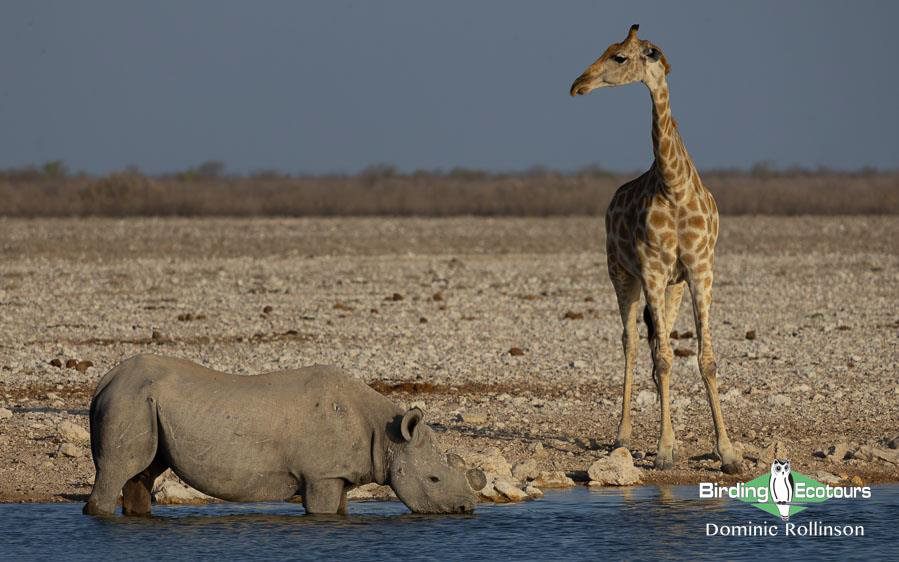
We were treated to scenes like this in Etosha. Here a Black Rhinoceros and a Giraffe compete for a waterhole.
We then entered Namutoni Camp (another old German fort) and enjoyed a late lunch. After lunch, we took a walk across to the waterhole, which had a few interesting birds around such as Allen’s Gallinule (an unusual record for Etosha), Marsh Sandpiper and Marabou Stork. Other quality birds seen around Namutoni included African Cuckoo, Southern White-crowned Shrike, Red-faced Mousebird, Marico Sunbird, Red-billed Buffalo Weaver and Lesser Masked Weaver.
We returned to our lovely lodge in the late afternoon and enjoyed the early afternoon at our leisure. A late afternoon walk did not produce too much different, although we did enjoy further looks at Pearl-spotted Owlet and Emerald-spotted Wood Dove.
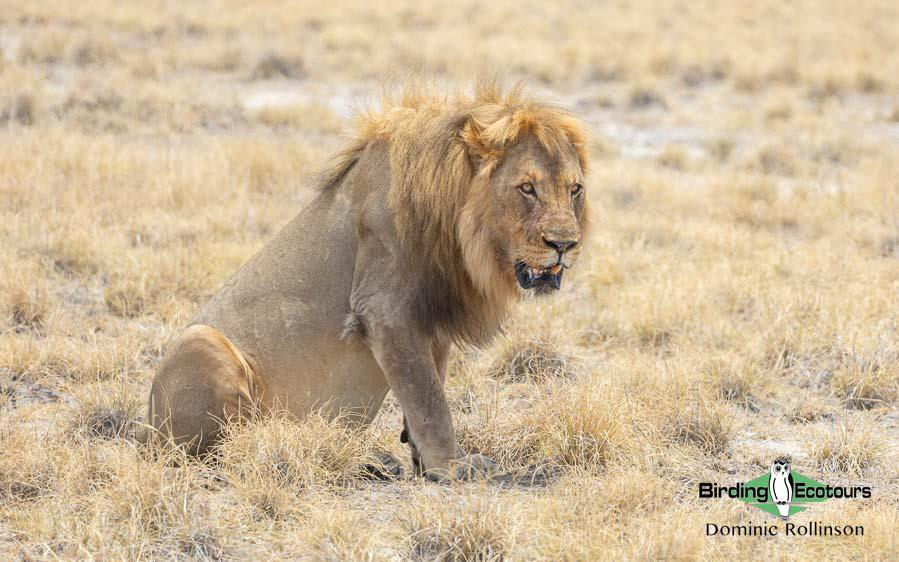
A trip to Etosha is never complete without a Lion sighting.
Day 9, 10th November 2024. Etosha National Park to the Kavango East Region
We had another long drive ahead of us today and so, after an early morning walk around the lodge (adding Carp’s Tit, Chestnut Weaver, Black Cuckoo, Black-faced Waxbill and African Paradise Flycatcher), we had our breakfast and loaded up the van. We made a big movement east today, which resulted in a big change in the habitat as we entered the lusher Kavango East Region. Here tall woodlands dominate, and, in these woodlands, we came cross Wahlberg’s Eagle, Magpie Shrike and Fawn-colored Lark.
In the early afternoon, we arrived at our lodge, which is ideally set along the edge of the Cubango River, overlooking Angola, and we took some time off after the long drive. Some late afternoon birding around the lodge grounds resulted in many new species, with the crème de la crème being the long-staying vagrant Ross’s Turaco (well found by Tim). This species is extremely rare in Namibia, however, this lone bird has now been around the lodge grounds for the last couple of years and has entertained many twitchers and birders! The birding around the lodge grounds was, as usual, very productive and we added many new birds. Some of the highlights here included Senegal Coucal, Red-chested Cuckoo, Common Swift, African Wattled Lapwing, African Openbill, Woodland Kingfisher, Meyer’s Parrot, Swamp Boubou, Terrestrial Brownbul, Arrow-marked Babbler, Kurrichane Thrush, White-browed Robin-Chat, Holub’s Golden Weaver and Southern Brown-throated Weaver.
Later that evening, after dinner, we popped out briefly and soon managed to find the calling African Barred Owlet which we had heard earlier.
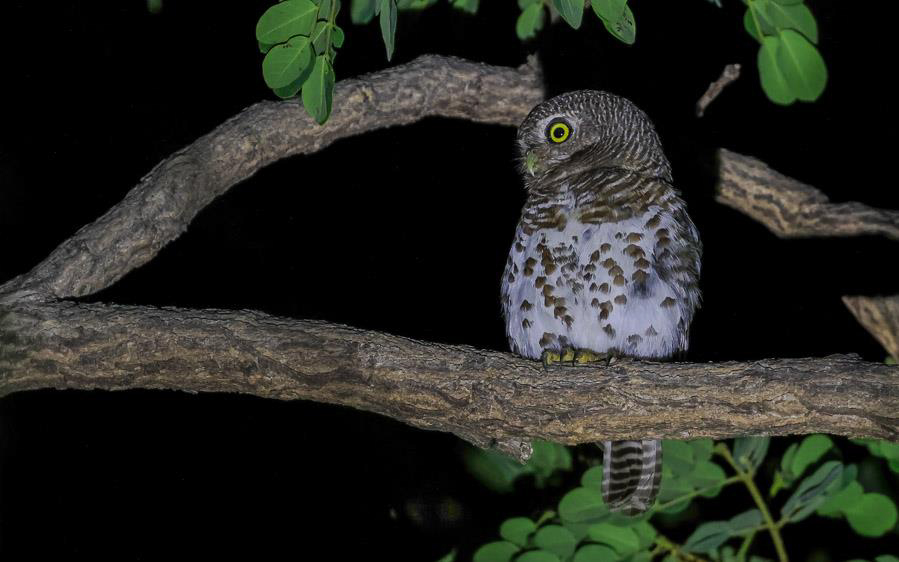
African Barred Owlet was seen on a nocturnal walk (photo Nico Heyning).
Day 10, 11th November 2024. East through the Kavango East Region, into Botswana
We spent a couple of hours before breakfast, birding around the property, which was very bird-rich and we further added Hartlaub’s Babbler, Ashy Flycatcher and Red-eyed Dove to our rapidly growing list. We made it back to the dining area just as the heavens opened and for the next 30 minutes or so we watched an almighty downpour.
After breakfast we loaded up the van and carried on eastwards. We stopped at the sewage works just outside of Rundu, where we quickly added Red-knobbed Coot, African Swamphen and Lesser Swamp Warbler. Over the next couple of hours, we enjoyed a couple birding stops in dense woodland along the way, which added the likes of White-breasted Cuckooshrike (brief flight views for some), Tinkling Cisticola, Southern Black Flycatcher and Yellow-throated Bush Sparrow.
We arrived at the Muhembo border crossing in the early afternoon which, as usual, was quick and painless and before we knew it, we were in Botswana and making our way towards the town of Shakawe. We were staying at Xaro Lodge, a lovely lodge on the edge of the Okavango Panhandle and soon caught the boat to our lodge. The boat ride to our lodge added our first looks at African Skimmer, Collared Pratincole, Striated Heron, Purple Heron, Giant and Malachite Kingfishers, Broad-billed Roller and Chirping Cisticola. After checking into our rooms, we enjoyed a quick walk around the property, which further yielded Green Wood Hoopoe and Meves’s Starling.
We finished the day, with a drink in hand, overlooking the Kavango River as we watched flyover Great White Egret, Purple Heron and White-faced Whistling Duck. That night some of us heard the distant boom of Pel’s Fishing Owl, hopefully a good omen for tomorrow’s adventure!
Day 11, 12th November 2024. Okavango Panhandle boat cruise and birding
We started the morning with a walk around the tall riverine forest and woodland at the back of the property (with the lodge’s guide, Tom) with our main target being a large ginger owl. It took some time but eventually Tom spotted a roosting Pel’s Fishing Owl high up in a tree. We enjoyed prolonged views of this most-wanted owl, although it was quite obscured by thick vegetation. Other highlights of this walk included Mourning Collared Dove, African Green Pigeon, Square-tailed Nightjar, Saddle-billed Stork, Little Sparrowhawk, African Barred Owlet, Greater Honeyguide, Meyer’s Parrot and Broad-billed Roller. Once back at the lodge we enjoyed observing some of the roosting bats in the area, including Peter’s Epauletted Fruit Bat and Mauritian Tomb Bat.
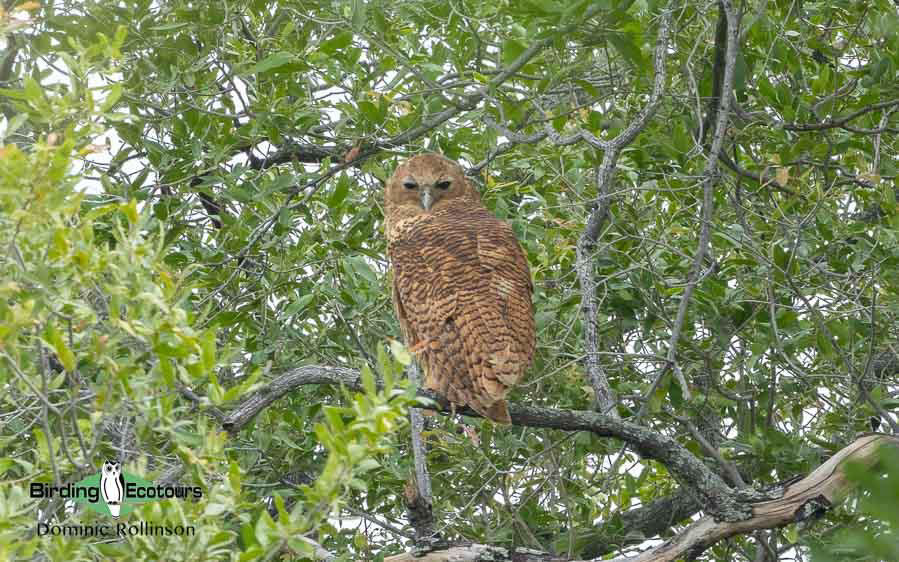
Pel’s Fishing Owl was a strong candidate for bird of the trip.
After our early morning walk, we enjoyed a quick sit-down breakfast before heading out on our first boat trip of the day. This morning we headed south along the panhandle, with the aim of making it to a nearby floodplain. En route to the floodplain we had some fine views of Coppery-tailed Coucal, African Swamphen, Black Crake, Water Thick-knee, Long-toed Lapwing, African Skimmer, Goliath Heron, African Marsh Harrier and African Fish Eagle. Along the way, we also had brief looks at a Rufous-bellied Heron as it flew by us. Arriving at the floodplain we took a walk out and eventually had good looks at Slaty Egrets feeding alongside Black Herons and Yellow-billed Egrets. The Okavango wetlands must represent one of the most reliable places in the world to see Slaty Egret, a rather range-restricted species. While out on the floodplain, we also added Plain-backed Pipit, another new bird for our list. On our way back to the lodge, Tom picked out a roosting White-backed Night Heron, hidden deep in some riverside vegetation.
Later that afternoon, after a few hours off during the midday heat, we headed back out in the boat and this time made our way northwards along the main channel. Highlights of the afternoon included African Pygmy Goose, Common Swift, African Snipe, European Honey Buzzard, Blue-cheeked Bee-eater, Greater Swamp Warbler, Southern Brown-throated Weaver and Fan-tailed Widowbird. We again ended the day enjoying a drink on the banks of the Cubango River, while watching various herons and egrets flying by, including Black-crowned Night Heron and African Sacred Ibis which were both new trip birds.
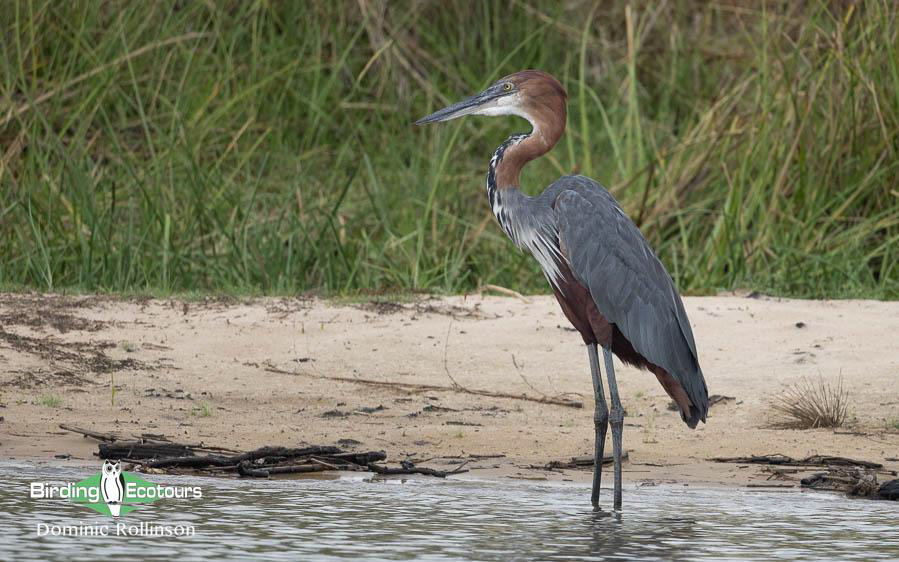
Massive Goliath Herons were enjoyed along our Okavango boat cruises.
Day 12, 13th November 2024. Back into Namibia and birding the Mahango area
We again decided to take a walk in the woodland behind the lodge to try improve our views of Pel’s Fishing Owl and see what else we might find here. This morning the owl proved more co-operative as it sat out on a more exposed perch, allowing us to improve our views and photos. Other nice additions this morning included African Golden Oriole and Grey Tit-Flycatcher, unfortunately the calling Little Rush Warblers would not show themselves though.
We bade our farewells to Xaro Lodge and made our way back through the Botswana-Namibia border, which again proved quick and easy. We took our time as we made our way back north through Mahangu Game Reserve and enjoyed large numbers of birds and animals out in the floodplain and in the surrounding woodlands. Some of our avian highlights for the couple of hours spent here included White-browed Coucal, Wattled Crane (as many as five birds!), Long-toed Lapwing, Collared Pratincole, African Openbill, Marabou and Yellow-billed Storks, Little Bee-eater, Lesser Grey Shrike, Fawn-colored Lark, Burnt-necked Eremomela and Kurrichane Thrush. We were also entertained by large numbers of animals such as African Savanna Elephant, Plains Zebra, Common Warthog, Common Hippopotamus and several antelope species including Tsessebe, Impala, Southern Lechwe, Southern Reedbuck and Southern Bushbuck.
We arrived at our accommodation along the edge of the Cubango River (this time in Namibia) in the early afternoon and enjoyed some time off during the heat of the day. Once it had cooled down a bit, we boarded our private boat and enjoyed a relaxed trip along the Cubango River. One of our early stops was a Southern Carmine Bee-eater colony, where we spent a while enjoying eye-level views of these beautifully colored bee-eaters, with Little and White-fronted Bee-eaters also seen nearby. Other standout species on our boat cruise included Knob-billed Duck, Rock Pratincole, African Skimmer, White-winged Tern, Striated Heron, Swallow-tailed Bee-eater and Holub’s Golden Weaver. To finish the boat trip, we enjoyed sundowners on a small island overlooking Popa Falls, with a distant storm rumbling in the background.
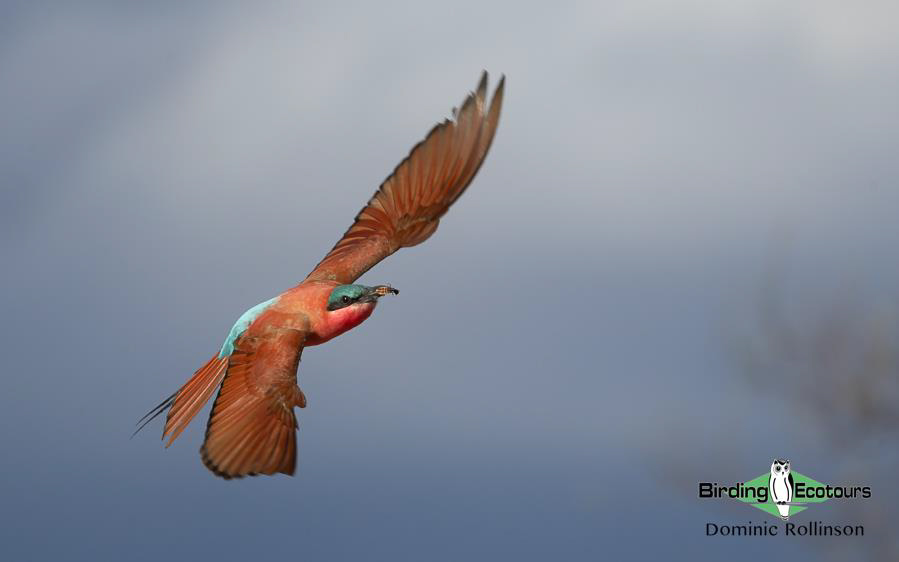
We enjoyed close-up views of a colony of Southern Carmine Bee-eaters along the Cubango River.
Day 13, 14th November 2024. Birding the Mahangu area
This morning we had a very early start so that we could arrive in woodlands about 50 miles (70 kilometers) west of Divundu to look for a few scarce and localized targets; namely Souza’s Shrike, Sharp-tailed Starling and Rufous-bellied Tit. We picked up the area’s local guide and expert, Christoph, and made our way west and managed to arrive just after sunrise. After a quick bite to eat, we set off into the woodlands and quickly started finding interesting bird species such as Shikra, Grey-headed Kingfisher, Purple Roller, Yellow-fronted Tinkerbird, Brown-backed Honeybird, Chinspot Batis, Fawn-colored Lark, Tinkling Cisticola, Neddicky (Piping Cisticola), Southern Yellow White-eye, Pale and Southern Black Flycatchers and Yellow-fronted Canary. After about 30 minutes we arrived at the Souza’s Shrike territory and soon thereafter we found the bird in question and managed prolonged looks at this scarce resident.
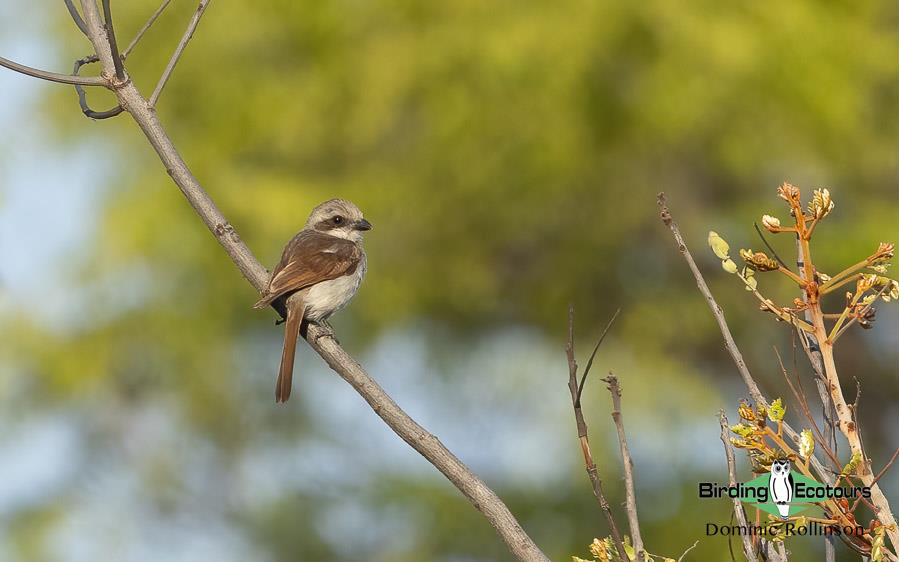
Souza’s Shrike was one of our targets in the woodlands west of Divundu.
We then moved to another nearby patch of woodland where we soon found Sharp-tailed Starling and also found a few attractive Cut-throat Finches while looking at the starling. After some work we eventually had prolonged and nearby views of a group of about six Sharp-tailed Starlings which were great to see. We spent some time birding the general area here and managed to further add Diederik and African Cuckoos, Striped Kingfisher, Black-headed Oriole, African Paradise Flycatcher, Yellow-billed Oxpecker, Arnot’s Chat and Golden-breasted Bunting. Despite searching a few other areas for the Rufous-bellied Tit, we eventually had to accept fate and made our way back to our lodge for lunch.
We again took time off during the heat of the day, then headed out to a nearby floodplain which we birded for a couple of hours and managed to add a few new species. We had hoped to find Temminck’s Coursers here and it did not take too long for a small group to show and provide us with good looks. Other highlights here included Meyer’s Parrot, White-throated, Lesser Striped and Mosque Swallows as well as Lesser Grey Shrike. We spent some time scanning the river which further added Water Thick-knee, Common Greenshank, African Skimmer and Collared Pratincole.
Day 14, 15th November 2024. Transfer to Zambezi Region
We had a long drive ahead of us today, so started with a relaxed walk in the area surrounding the lodge. The birding was a little slow this morning, but we did eventually add Brown-crowned Tchagra, Black-faced Waxbill, Village Indigobird and drastically improved our views of Bradfield’s Hornbill,with a confiding bird seen displaying nearby to us.
After breakfast, we loaded up the van and hit the long straight road to Katima Mulilo, as we continued on our way eastwards through the Zambezi Region. Excitingly, we drove through Caprivi Game Park for some of the journey and a couple of roadside stops added Martial Eagle, Bateleur, Lizard Buzzard and Common Ostrich, while the undoubted highlight was when Nico shouted out ‘Cheetah’ and we turned the van around to find a lone Cheetah sat just off the side of the road! We watched this regal animal for a while as it nonchalantly lay in the shade of a tree. We couldn’t believe our luck/Nico’s skill at spotting it and happily continued on our way east.
We arrived at our next lodge just outside Katima Mulilo, on the banks of the Zambezi River, in the early afternoon and boarded a boat to enjoy another private boat cruise. Our big target this afternoon was African Finfoot, which did not prove tricky to find, and over the course of the cruise we probably found five or six different individuals. Once finfoot was sorted, we moved onto other species and managed to further find Schalow’s Turaco, White-browed Coucal, White-crowned Lapwing, Greater Painted-snipe, African Skimmer, White-backed Night Heron, Giant and Brown-hooded Kingfishers, Pale-throated Greenbul and Holub’s Golden Weaver.
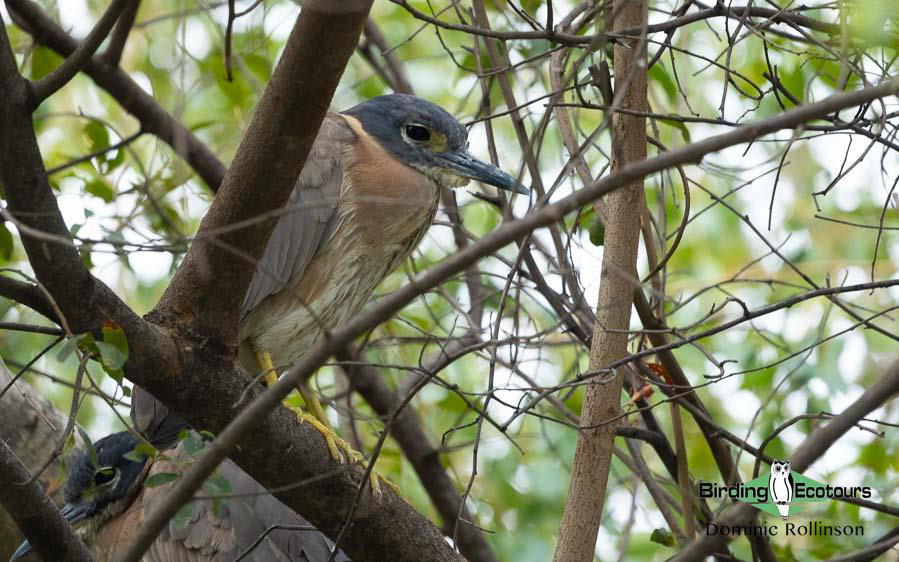
We had relatively good views of White-backed Night Heron along the Zambezi River.
After dinner (with African Wood Owl as nice distraction), the day was not yet done, as a few of us headed out on a night drive to look for various owls and nightjars. Our main target was the spectacular Pennant-winged Nightjar and an impressive male duly obliged for us and gave us fantastic looks as it flew leisurely by, with full pennants on display! While out in the woodlands, we managed to find Fiery-necked Nightjar, African Scops Owl and Southern White-faced Owl. A fitting end to another wonderful day’s birding!
Day 15, 16th November 2024. Katima Mulilo birding
We had the full day to explore the exciting wetlands and woodlands of this incredibly bird-rich corner of Namibia and set out early to look for a pair of African Broadbills which had recently been seen nearby. Unfortunately, the broadbills were a no-show, but we did manage to find Trumpeter Hornbill, Eastern Nicator and White-browed Coucal in the general area, before the consistent drizzle got a bit much for us. On the way back to the lodge, we birded some nearby woodlands which held Eurasian Golden Oriole and a pair of showy Grey-headed Bushshrikes.
While enjoying breakfast we had our first looks at Bronze Mannikin and Common Myna (an invasive species in Namibia). Then we headed out again to see some nearby mature woodlands which often hold some good birds. These woodlands were a little on the quiet side this morning, but we did manage to find African Golden Oriole, White-crested Helmetshrike and Woodland Kingfisher. Another patch of woodlands was far more productive as we found Klaas’s Cuckoo, Little Bee-eater, Yellow-fronted Tinkerbird, Black-crowned Tchagra, Tropical Boubou and a pair of Brown Firefinches.
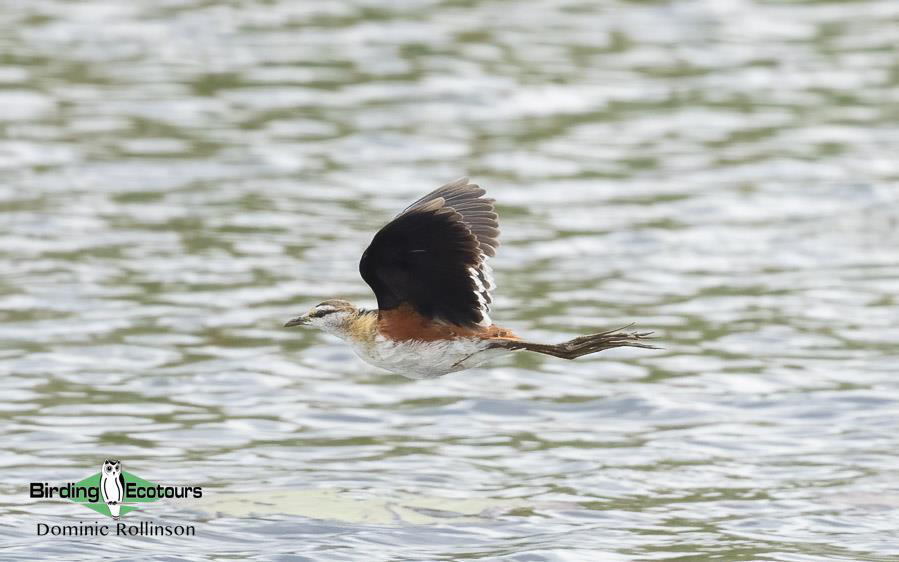
Lesser Jacanas are seen reliably around Katima Mulilo.
With the temperature rising, we decided to go bird some nearby wetlands. This turned out to be a good idea, as we found an obliging pair of Lesser Jacanas alongside Blue-billed Teal, Long-toed Lapwing, African Snipe, Marsh Sandpiper, Malachite Kingfisher and Fan-tailed Widowbird. We were also excited to find a single Wood Pipit nearby, a rare bird in Namibia! A showy Lilac-breasted Roller was enjoyed by us all, and particularly by Ruth who had been hoping for a Lilac-breasted Roller in glorious morning light!
We took our usual downtime during the heat of the day, before heading out in the late afternoon to bird the Chobe River floodplain. The heat was rather oppressive this afternoon, which likely explained why the birding was a bit on the slow side. We did, however, manage to eke out a few good birds in the form of Greater Blue-eared Starling, African Openbill and Dark Chanting Goshawk. We tried a couple areas for Collared Palm Thrush but, in the end, we had to settle for a showy Bearded Woodpecker (with Olive Woodpecker also seen around the lodge that afternoon). That evening we enjoyed a tasty dinner followed by birthday cake to celebrate with Todd.
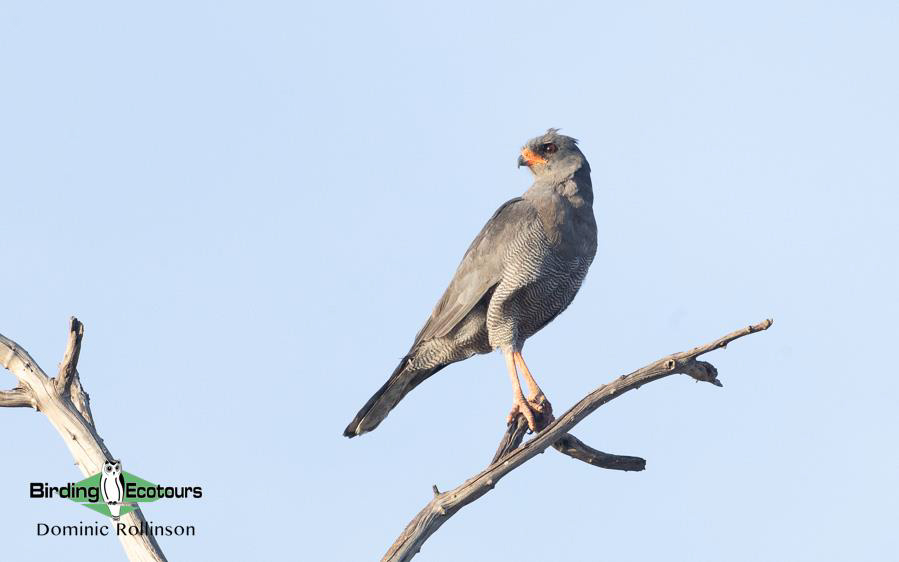
It took a while, but we eventually had good looks at Dark Chanting Goshawk.
Day 16, 17th November 2024. Katima Mulilo to Livingstone
We had the morning to bird around Katima Mulilo, before we headed into Zambia, and so we again birded the nearby woodlands to try for African Broadbill, which were again not around. The birding in the general area was, however, much better this morning and we managed to find Crested Francolin, African Emerald Cuckoo, Black Sparrowhawk, Broad-billed Roller, Black Cuckooshrike and White-bellied Sunbird. Some nearby riverine woodlands produced some fantastic views of several feeding Schalow’s Turacos, along with African Green Pigeon, Green Wood Hoopoe, Garden Warbler, Purple-banded Sunbird and Southern Black Tit.
It was then time to load up the van and make our way further east towards Livingstone. We made the crossing into Zambia by going through Botswana and Chobe National Park. The park itself was rather quiet (heat of the day) but we did find White-backed Vulture, Marabou Stork (feeding in the local landfill) and Tawny Eagle. The Zambia border crossing took a while (as it always does, moving from counter to counter, with lots of paperwork to fill out) but we eventually made it into our beautiful lodge in the early afternoon.
This afternoon we boarded a boat for another Zambezi boat cruise, always a great way to end the day. While out on the water we enjoyed looks at some huge Common Hippopotamus and Nile Crocodiles, with some of the avian highlights including White-crowned Lapwing, Rock Pratincole, Whiskered Tern, Yellow-billed Stork, White-breasted Cormorant, Goliath Heron, Pink-backed and Great White Pelicans, Osprey, Hooded Vulture and Ayres’s Hawk-Eagle. Watching two African Savanna Elephants coming down to drink in the late afternoon light was certainly another highlight. The cruise ended with an impressive sunset before we headed back to the lodge for another tasty dinner.
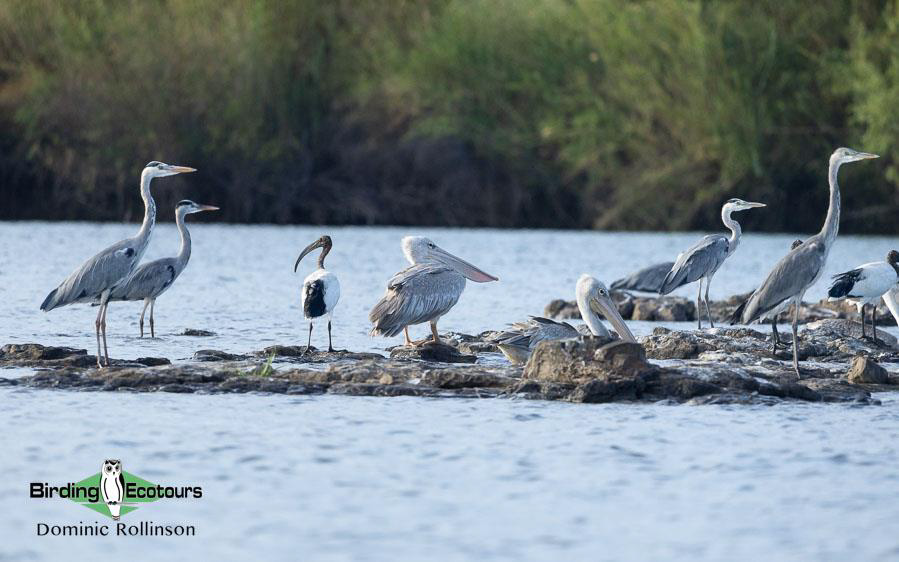
We enjoyed an assortment of waterbirds on our Zambezi boat cruise including Grey Heron, African Sacred Ibis and Pink-backed Pelican.
Day 17, 18th November 2024. Victoria Falls and Livingstone birding
Today was the final full day of the tour and we headed out early to some nearby miombo woodland to see if there were any last-minute list additions. The woodlands were quiet to begin with but things soon picked up, with Racket-tailed Roller (a displaying bird), African Golden Oriole, Stierling’s Wren-Warbler and Bearded Woodpecker all seen. We were excited to have nice looks at both Eurasian and African Hobbies feeding overhead. The undoubted highlight of the morning was hearing and seeing (well spotted by Nico, of course) a group of Southern Ground Hornbills. These huge terrestrial hornbills are always a crowd favorite!
Breakfast, on the deck overlooking the Zambezi River, was very pleasant and then it was time to head into the van and spend the morning at Victoria Falls. The falls themselves are generally more impressive from the Zimbabwean side and so, after negotiating the border (a much quicker process today), we enjoyed a couple hours walking around the falls area, admiring this World Heritage Site. One of the local names for the falls is Mosi-oa Tunya which means ‘the smoke that thunders’ and this name is certainly appropriate. We, of course, were looking out for birds while enjoying the falls and new birds here included Bearded Scrub Robin, Red-throated Twinspot and Red-winged Starling.
This afternoon (once back in Zambia) some went out on another sunset boat cruise, while a few of us took a leisurely walk around the lodge grounds, which produced Natal Spurfowl, White-browed Coucal, Red-faced Cisticola, Bearded Scrub Robin and Collared Palm Thrush. Later that evening we enjoyed our final dinner of the trip and reminisced on an enjoyable and successful trip through southern Africa.
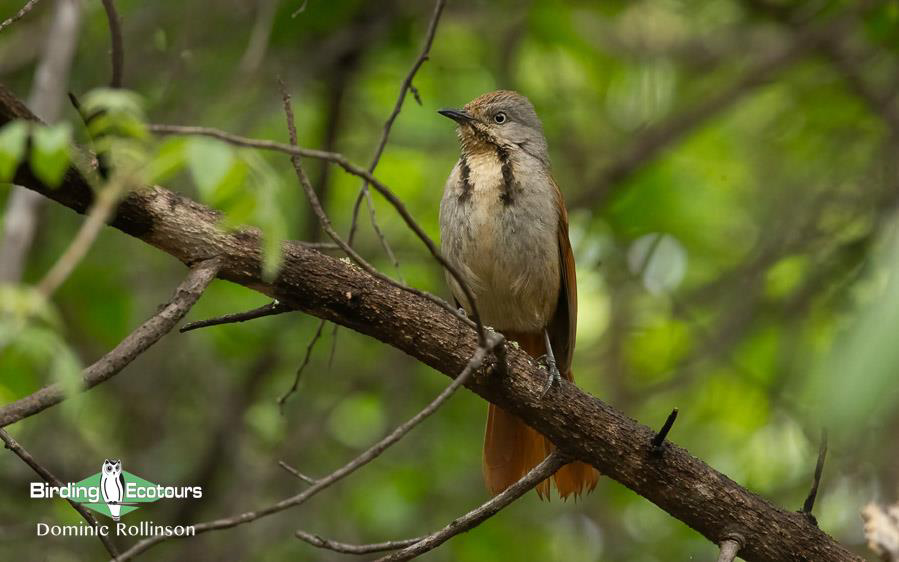
Collared Palm Thrush showed well in the riparian forest on the edge of the Zambezi River.
Day 18, 19th November 2024. Livingstone birding and departure
To finish off the trip’s birding we took a leisurely stroll around the lodge grounds, which added more of yesterday afternoon’s birds, along with Schalow’s Turaco, African Goshawk, Violet-backed Starling and Red-headed Weaver.
We then enjoyed breakfast and most of us headed towards Livingstone Airport, saying goodbye to Angie and Larry (who had a couple nights at the lodge). Thanks everyone for a highly enjoyable and successful tour, I hope to travel with you all again soon!
Bird List – Following IOC (Version 14.2/August 2024)
Birds ‘heard only’ are marked with (H) after the common name, all other species were seen.
The following notation after species names is used to show conservation status following BirdLife International: CR = Critically Endangered, EN = Endangered, VU = Vulnerable, NT = Near Threatened.
| Common name | Scientific name |
| Ostriches (Struthionidae) | |
| Common Ostrich | Struthio camelus |
| Ducks, Geese, Swans (Anatidae) | |
| White-faced Whistling Duck | Dendrocygna viduata |
| Spur-winged Goose | Plectropterus gambensis |
| Knob-billed Duck | Sarkidiornis melanotos |
| Egyptian Goose | Alopochen aegyptiaca |
| South African Shelduck | Tadorna cana |
| African Pygmy Goose | Nettapus auritus |
| Blue-billed Teal | Spatula hottentota |
| Cape Teal | Anas capensis |
| Red-billed Teal | Anas erythrorhyncha |
| Guineafowl (Numididae) | |
| Helmeted Guineafowl | Numida meleagris |
| Pheasants & Allies (Phasianidae) | |
| Crested Francolin | Ortygornis sephaena |
| Red-billed Spurfowl | Pternistis adspersus |
| Natal Spurfowl | Pternistis natalensis |
| Swainson’s Spurfowl | Pternistis swainsonii |
| Nightjars (Caprimulgidae) | |
| Rufous-cheeked Nightjar | Caprimulgus rufigena |
| Fiery-necked Nightjar | Caprimulgus pectoralis |
| Freckled Nightjar | Caprimulgus tristigma |
| Square-tailed Nightjar | Caprimulgus fossii |
| Pennant-winged Nightjar | Caprimulgus vexillarius |
| Swifts (Apodidae) | |
| African Palm Swift | Cypsiurus parvus |
| Common Swift | Apus apus |
| Little Swift | Apus affinis |
| White-rumped Swift | Apus caffer |
| Turacos (Musophagidae) | |
| Grey Go-away-bird | Crinifer concolor |
| Ross’s Turaco | Tauraco rossae |
| Schalow’s Turaco | Tauraco schalowi |
| Bustards (Otididae) | |
| Kori Bustard | Ardeotis kori |
| Rüppell’s Korhaan | Heterotetrax rueppelii |
| Red-crested Korhaan | Lophotis ruficrista |
| Northern Black Korhaan | Afrotis afraoides |
| Cuckoos (Cuculidae) | |
| Senegal Coucal | Centropus senegalensis |
| Coppery-tailed Coucal | Centropus cupreicaudus |
| White-browed Coucal | Centropus superciliosus |
| Levaillant’s Cuckoo | Clamator levaillantii |
| Jacobin Cuckoo | Clamator jacobinus |
| Diederik Cuckoo | Chrysococcyx caprius |
| Klaas’s Cuckoo | Chrysococcyx klaas |
| African Emerald Cuckoo | Chrysococcyx cupreus |
| Black Cuckoo | Cuculus clamosus |
| Red-chested Cuckoo | Cuculus solitarius |
| African Cuckoo | Cuculus gularis |
| Sandgrouse (Pteroclidae) | |
| Namaqua Sandgrouse | Pterocles namaqua |
| Double-banded Sandgrouse | Pterocles bicinctus |
| Burchell’s Sandgrouse | Pterocles burchelli |
| Pigeons, Doves (Columbidae) | |
| Rock Dove | Columba livia |
| Speckled Pigeon | Columba guinea |
| Mourning Collared Dove | Streptopelia decipiens |
| Red-eyed Dove | Streptopelia semitorquata |
| Ring-necked Dove | Streptopelia capicola |
| Laughing Dove | Spilopelia senegalensis |
| Emerald-spotted Wood Dove | Turtur chalcospilos |
| Namaqua Dove | Oena capensis |
| African Green Pigeon | Treron calvus |
| Finfoots (Heliornithidae) | |
| African Finfoot | Podica senegalensis |
| Rails, Crakes & Coots (Rallidae) | |
| Common Moorhen | Gallinula chloropus |
| Red-knobbed Coot | Fulica cristata |
| Allen’s Gallinule | Porphyrio alleni |
| African Swamphen | Porphyrio madagascariensis |
| Black Crake | Zapornia flavirostra |
| Cranes (Gruidae) | |
| Wattled Crane – VU | Grus carunculata |
| Blue Crane – VU | Grus paradisea |
| Grebes (Podicipedidae) | |
| Little Grebe | Tachybaptus ruficollis |
| Flamingos (Phoenicopteridae) | |
| Greater Flamingo | Phoenicopterus roseus |
| Lesser Flamingo | Phoeniconaias minor |
| Stone-curlews, Thick-knees (Burhinidae) | |
| Water Thick-knee | Burhinus vermiculatus |
| Oystercatchers (Haematopodidae) | |
| African Oystercatcher | Haematopus moquini |
| Stilts, Avocets (Recurvirostridae) | |
| Black-winged Stilt | Himantopus himantopus |
| Pied Avocet | Recurvirostra avosetta |
| Plovers (Charadriidae) | |
| Grey Plover | Pluvialis squatarola |
| Common Ringed Plover | Charadrius hiaticula |
| Three-banded Plover | Charadrius tricollaris |
| Long-toed Lapwing | Vanellus crassirostris |
| Blacksmith Lapwing | Vanellus armatus |
| White-crowned Lapwing | Vanellus albiceps |
| Crowned Lapwing | Vanellus coronatus |
| African Wattled Lapwing | Vanellus senegallus |
| Chestnut-banded Plover | Anarhynchus pallidus |
| White-fronted Plover | Anarhynchus marginatus |
| Painted-snipes (Rostratulidae) | |
| Greater Painted-snipe | Rostratula benghalensis |
| Jacanas (Jacanidae) | |
| Lesser Jacana | Microparra capensis |
| African Jacana | Actophilornis africanus |
| Sandpipers, Snipes (Scolopacidae) | |
| Eurasian Whimbrel | Numenius phaeopus |
| Bar-tailed Godwit | Limosa lapponica |
| African Snipe | Gallinago nigripennis |
| Common Sandpiper | Actitis hypoleucos |
| Marsh Sandpiper | Tringa stagnatilis |
| Wood Sandpiper | Tringa glareola |
| Common Greenshank | Tringa nebularia |
| Ruddy Turnstone | Arenaria interpres |
| Ruff | Calidris pugnax |
| Curlew Sandpiper | Calidris ferruginea |
| Sanderling | Calidris alba |
| Little Stint | Calidris minuta |
| Coursers, Pratincoles (Glareolidae) | |
| Double-banded Courser | Rhinoptilus africanus |
| Temminck’s Courser | Cursorius temminckii |
| Rock Pratincole | Glareola nuchalis |
| Collared Pratincole | Glareola pratincola |
| Gulls, Terns, Skimmers (Laridae) | |
| African Skimmer | Rynchops flavirostris |
| Damara Tern | Sternula balaenarum |
| Caspian Tern | Hydroprogne caspia |
| Whiskered Tern | Chlidonias hybrida |
| Black Tern | Chlidonias niger |
| White-winged Tern | Chlidonias leucopterus |
| Arctic Tern | Sterna paradisaea |
| Common Tern | Sterna hirundo |
| Sandwich Tern | Thalasseus sandvicensis |
| Greater Crested Tern | Thalasseus bergii |
| Hartlaub’s Gull | Chroicocephalus hartlaubii |
| Kelp Gull | Larus dominicanus |
| Northern Storm Petrels (Hydrobatidae) | |
| European Storm Petrel | Hydrobates pelagicus |
| Petrels, Shearwaters, Diving Petrels (Procellariidae) | |
| White-chinned Petrel – VU | Procellaria aequinoctialis |
| Sooty Shearwater | Ardenna grisea |
| Storks (Ciconiidae) | |
| African Openbill | Anastomus lamelligerus |
| Marabou Stork | Leptoptilos crumenifer |
| Yellow-billed Stork | Mycteria ibis |
| Saddle-billed Stork | Ephippiorhynchus senegalensis |
| Anhingas, Darters (Anhingidae) | |
| African Darter | Anhinga rufa |
| Cormorants, Shags (Phalacrocoracidae) | |
| Reed Cormorant | Microcarbo africanus |
| Crowned Cormorant | Microcarbo coronatus |
| Cape Cormorant – EN | Phalacrocorax capensis |
| White-breasted Cormorant | Phalacrocorax lucidus |
| Ibises, Spoonbills (Threskiornithidae) | |
| African Sacred Ibis | Threskiornis aethiopicus |
| Hadada Ibis | Bostrychia hagedash |
| Glossy Ibis | Plegadis falcinellus |
| Herons, Bitterns (Ardeidae) | |
| Black-crowned Night Heron | Nycticorax nycticorax |
| Slaty Egret – VU | Egretta vinaceigula |
| Black Heron | Egretta ardesiaca |
| Little Egret | Egretta garzetta |
| White-backed Night Heron | Calherodius leuconotus |
| Striated Heron | Butorides striata |
| Rufous-bellied Heron | Ardeola rufiventris |
| Squacco Heron | Ardeola ralloides |
| Western Cattle Egret | Bubulcus ibis |
| Great Egret | Ardea alba |
| Yellow-billed Egret | Ardea brachyrhyncha |
| Grey Heron | Ardea cinerea |
| Purple Heron | Ardea purpurea |
| Black-headed Heron | Ardea melanocephala |
| Goliath Heron | Ardea goliath |
| Hamerkop (Scopidae) | |
| Hamerkop | Scopus umbretta |
| Pelicans (Pelecanidae) | |
| Great White Pelican | Pelecanus onocrotalus |
| Pink-backed Pelican | Pelecanus rufescens |
| Ospreys (Pandionidae) | |
| Osprey | Pandion haliaetus |
| Kites, Hawks, Eagles (Accipitridae) | |
| Black-winged Kite | Elanus caeruleus |
| European Honey Buzzard | Pernis apivorus |
| Hooded Vulture – CR | Necrosyrtes monachus |
| White-backed Vulture – CR | Gyps africanus |
| Lappet-faced Vulture – EN | Torgos tracheliotos |
| Black-chested Snake Eagle | Circaetus pectoralis |
| Bateleur – EN | Terathopius ecaudatus |
| Martial Eagle – EN | Polemaetus bellicosus |
| Wahlberg’s Eagle | Hieraaetus wahlbergi |
| Ayres’s Hawk-Eagle | Hieraaetus ayresii |
| Tawny Eagle – VU | Aquila rapax |
| Verreaux’s Eagle | Aquila verreauxii |
| African Hawk-Eagle | Aquila spilogaster |
| Lizard Buzzard | Kaupifalco monogrammicus |
| Gabar Goshawk | Micronisus gabar |
| Dark Chanting Goshawk | Melierax metabates |
| Pale Chanting Goshawk | Melierax canorus |
| African Goshawk | Accipiter tachiro |
| Shikra | Accipiter badius |
| Little Sparrowhawk | Accipiter minullus |
| Black Sparrowhawk | Accipiter melanoleucus |
| African Marsh Harrier | Circus ranivorus |
| Yellow-billed Kite | Milvus aegyptius |
| African Fish Eagle | Icthyophaga vocifer |
| Common Buzzard | Buteo buteo |
| Barn Owls (Tytonidae) | |
| Western Barn Owl | Tyto alba |
| Owls (Strigidae) | |
| Pearl-spotted Owlet | Glaucidium perlatum |
| African Barred Owlet | Glaucidium capense |
| African Scops Owl | Otus senegalensis |
| Southern White-faced Owl | Ptilopsis granti |
| Pel’s Fishing Owl | Scotopelia peli |
| African Wood Owl | Strix woodfordii |
| Mousebirds (Coliidae) | |
| Red-faced Mousebird | Urocolius indicus |
| Hoopoes (Upupidae) | |
| African Hoopoe | Upupa africana |
| Wood Hoopoes (Phoeniculidae) | |
| Green Wood Hoopoe | Phoeniculus purpureus |
| Violet Wood Hoopoe | Phoeniculus damarensis |
| Common Scimitarbill | Rhinopomastus cyanomelas |
| Ground Hornbills (Bucorvidae) | |
| Southern Ground Hornbill – VU | Bucorvus leadbeateri |
| Hornbills (Bucerotidae) | |
| Damara Red-billed Hornbill | Tockus damarensis |
| Southern Red-billed Hornbill | Tockus rufirostris |
| Monteiro’s Hornbill | Tockus monteiri |
| Southern Yellow-billed Hornbill | Tockus leucomelas |
| Bradfield’s Hornbill | Lophoceros bradfieldi |
| African Grey Hornbill | Lophoceros nasutus |
| Trumpeter Hornbill | Bycanistes bucinator |
| Rollers (Coraciidae) | |
| Purple Roller | Coracias naevius |
| Racket-tailed Roller | Coracias spatulatus |
| Lilac-breasted Roller | Coracias caudatus |
| Broad-billed Roller | Eurystomus glaucurus |
| Kingfishers (Alcedinidae) | |
| Grey-headed Kingfisher | Halcyon leucocephala |
| Brown-hooded Kingfisher | Halcyon albiventris |
| Striped Kingfisher | Halcyon chelicuti |
| Woodland Kingfisher | Halcyon senegalensis |
| Malachite Kingfisher | Corythornis cristatus |
| Giant Kingfisher | Megaceryle maxima |
| Pied Kingfisher | Ceryle rudis |
| Bee-eaters (Meropidae) | |
| Swallow-tailed Bee-eater | Merops hirundineus |
| Little Bee-eater | Merops pusillus |
| White-fronted Bee-eater | Merops bullockoides |
| Blue-cheeked Bee-eater | Merops persicus |
| European Bee-eater | Merops apiaster |
| Southern Carmine Bee-eater | Merops nubicoides |
| African Barbets (Lybiidae) | |
| Crested Barbet | Trachyphonus vaillantii |
| Yellow-fronted Tinkerbird | Pogoniulus chrysoconus |
| Acacia Pied Barbet | Tricholaema leucomelas |
| Black-collared Barbet | Lybius torquatus |
| Honeyguides (Indicatoridae) | |
| Brown-backed Honeybird | Prodotiscus regulus |
| Greater Honeyguide | Indicator indicator |
| Woodpeckers (Picidae) | |
| Golden-tailed Woodpecker | Campethera abingoni |
| Bearded Woodpecker | Chloropicus namaquus |
| Cardinal Woodpecker | Dendropicos fuscescens |
| Olive Woodpecker | Dendropicos griseocephalus |
| Caracaras, Falcons (Falconidae) | |
| Rock Kestrel | Falco rupicolus |
| Greater Kestrel | Falco rupicoloides |
| Red-necked Falcon | Falco chicquera |
| Eurasian Hobby | Falco subbuteo |
| African Hobby | Falco cuvierii |
| Lanner Falcon | Falco biarmicus |
| African & New World Parrots (Psittacidae) | |
| Meyer’s Parrot | Poicephalus meyeri |
| Rüppell’s Parrot | Poicephalus rueppellii |
| Old World Parrots (Psittaculidae) | |
| Rosy-faced Lovebird | Agapornis roseicollis |
| Wattle-eyes, Batises (Platysteiridae) | |
| Chinspot Batis | Batis molitor |
| Pririt Batis | Batis pririt |
| White-tailed Shrike | Lanioturdus torquatus |
| Bushshrikes (Malaconotidae) | |
| Grey-headed Bushshrike | Malaconotus blanchoti |
| Orange-breasted Bushshrike | Chlorophoneus sulfureopectus |
| Brown-crowned Tchagra | Tchagra australis |
| Black-crowned Tchagra | Tchagra senegalus |
| Black-backed Puffback | Dryoscopus cubla |
| Tropical Boubou | Laniarius major |
| Swamp Boubou | Laniarius bicolor |
| Crimson-breasted Shrike | Laniarius atrococcineus |
| Brubru | Nilaus afer |
| Vangas & Allies (Vangidae) | |
| White-crested Helmetshrike | Prionops plumatus |
| Cuckooshrikes (Campephagidae) | |
| White-breasted Cuckooshrike | Ceblepyris pectoralis |
| Black Cuckooshrike | Campephaga flava |
| Figbirds, Old World Orioles, Piopios (Oriolidae) | |
| Black-headed Oriole | Oriolus larvatus |
| African Golden Oriole | Oriolus auratus |
| Eurasian Golden Oriole | Oriolus oriolus |
| Drongos (Dicruridae) | |
| Fork-tailed Drongo | Dicrurus adsimilis |
| Monarchs (Monarchidae) | |
| African Paradise Flycatcher | Terpsiphone viridis |
| Shrikes (Laniidae) | |
| Southern White-crowned Shrike | Eurocephalus anguitimens |
| Magpie Shrike | Lanius melanoleucus |
| Souza’s Shrike | Lanius souzae |
| Southern Fiscal | Lanius collaris |
| Lesser Grey Shrike | Lanius minor |
| Red-backed Shrike | Lanius collurio |
| Crows, Jays (Corvidae) | |
| Cape Crow | Corvus capensis |
| Pied Crow | Corvus albus |
| Tits, Chickadees (Paridae) | |
| Southern Black Tit | Melaniparus niger |
| Carp’s Tit | Melaniparus carpi |
| Nicators (Nicatoridae) | |
| Eastern Nicator | Nicator gularis |
| Larks (Alaudidae) | |
| Spike-heeled Lark | Chersomanes albofasciata |
| Grey-backed Sparrow-Lark | Eremopterix verticalis |
| Sabota Lark | Calendulauda sabota |
| Fawn-colored Lark | Calendulauda africanoides |
| Dune Lark | Calendulauda erythrochlamys |
| Eastern Clapper Lark | Mirafra fasciolata |
| Rufous-naped Lark | Mirafra africana |
| Stark’s Lark | Spizocorys starki |
| Pink-billed Lark | Spizocorys conirostris |
| Red-capped Lark | Calandrella cinerea |
| Bulbuls (Pycnonotidae) | |
| Pale-throated Greenbul | Atimastillas flavicollis |
| Yellow-bellied Greenbul | Chlorocichla flaviventris |
| Terrestrial Brownbul | Phyllastrephus terrestris |
| African Red-eyed Bulbul | Pycnonotus nigricans |
| Dark-capped Bulbul | Pycnonotus tricolor |
| Swallows, Martins (Hirundinidae) | |
| Banded Martin | Neophedina cincta |
| Brown-throated Martin | Riparia paludicola |
| Large Rock Martin | Ptyonoprogne fuligula |
| Pearl-breasted Swallow | Hirundo dimidiata |
| Barn Swallow | Hirundo rustica |
| White-throated Swallow | Hirundo albigularis |
| Wire-tailed Swallow | Hirundo smithii |
| Greater Striped Swallow | Cecropis cucullata |
| Lesser Striped Swallow | Cecropis abyssinica |
| Red-breasted Swallow | Cecropis semirufa |
| Mosque Swallow | Cecropis senegalensis |
| Crombecs, African Warblers (Macrosphenidae) | |
| Rockrunner | Achaetops pycnopygius |
| Long-billed Crombec | Sylvietta rufescens |
| Leaf Warblers (Phylloscopidae) | |
| Willow Warbler | Phylloscopus trochilus |
| Reed Warblers & Allies (Acrocephalidae) | |
| Greater Swamp Warbler | Acrocephalus rufescens |
| Lesser Swamp Warbler | Acrocephalus gracilirostris |
| Grassbirds & Allies (Locustellidae) | |
| Little Rush Warbler | Bradypterus baboecala |
| Cisticolas & Allies (Cisticolidae) | |
| Red-faced Cisticola | Cisticola erythrops |
| Rattling Cisticola | Cisticola chiniana |
| Tinkling Cisticola | Cisticola rufilatus |
| Chirping Cisticola | Cisticola pipiens |
| Neddicky | Cisticola fulvicapilla |
| Zitting Cisticola | Cisticola juncidis |
| Desert Cisticola | Cisticola aridulus |
| Tawny-flanked Prinia | Prinia subflava |
| Black-chested Prinia | Prinia flavicans |
| Yellow-breasted Apalis | Apalis flavida |
| Rufous-eared Warbler | Malcorus pectoralis |
| Grey-backed Camaroptera | Camaroptera brevicaudata |
| Stierling’s Wren-Warbler | Calamonastes stierlingi |
| Barred Wren-Warbler | Calamonastes fasciolatus |
| Yellow-bellied Eremomela | Eremomela icteropygialis |
| Burnt-necked Eremomela | Eremomela usticollis |
| Sylviid Babblers (Sylviidae) | |
| Garden Warbler | Sylvia borin |
| Chestnut-vented Warbler | Curruca subcoerulea |
| White-eyes (Zosteropidae) | |
| Orange River White-eye | Zosterops pallidus |
| Southern Yellow White-eye | Zosterops anderssoni |
| Laughingthrushes & Allies (Leiothrichidae) | |
| Arrow-marked Babbler | Turdoides jardineii |
| Bare-cheeked Babbler | Turdoides gymnogenys |
| Southern Pied Babbler | Turdoides bicolor |
| Hartlaub’s Babbler | Turdoides hartlaubii |
| Black-faced Babbler | Turdoides melanops |
| Starlings, Rhabdornises (Sturnidae) | |
| Common Myna | Acridotheres tristis |
| Wattled Starling | Creatophora cinerea |
| Cape Starling | Lamprotornis nitens |
| Greater Blue-eared Starling | Lamprotornis chalybaeus |
| Meves’s Starling | Lamprotornis mevesii |
| Burchell’s Starling | Lamprotornis australis |
| Sharp-tailed Starling | Lamprotornis acuticaudus |
| Violet-backed Starling | Cinnyricinclus leucogaster |
| Pale-winged Starling | Onychognathus nabouroup |
| Oxpeckers (Buphagidae) | |
| Yellow-billed Oxpecker | Buphagus africanus |
| Red-billed Oxpecker | Buphagus erythrorynchus |
| Thrushes (Turdidae) | |
| Groundscraper Thrush | Turdus litsitsirupa |
| Kurrichane Thrush | Turdus libonyana |
| Chats, Old World Flycatchers (Muscicapidae) | |
| Bearded Scrub Robin | Cercotrichas quadrivirgata |
| Kalahari Scrub Robin | Cercotrichas paena |
| White-browed Scrub Robin | Cercotrichas leucophrys |
| Pale Flycatcher | Agricola pallidus |
| Chat Flycatcher | Agricola infuscatus |
| Grey Tit-Flycatcher | Fraseria plumbea |
| Ashy Flycatcher | Fraseria caerulescens |
| Southern Black Flycatcher | Melaenornis pammelaina |
| Herero Chat | Namibornis herero |
| Marico Flycatcher | Bradornis mariquensis |
| Spotted Flycatcher | Muscicapa striata |
| White-browed Robin-Chat | Cossypha heuglini |
| Collared Palm Thrush | Cichladusa arquata |
| Short-toed Rock Thrush | Monticola brevipes |
| Tractrac Chat | Emarginata tractrac |
| Ant-eating Chat | Myrmecocichla formicivora |
| Mountain Wheatear | Myrmecocichla monticola |
| Arnot’s Chat | Myrmecocichla arnotti |
| Familiar Chat | Oenanthe familiaris |
| Sunbirds (Nectariniidae) | |
| Collared Sunbird | Hedydipna collaris |
| Amethyst Sunbird | Chalcomitra amethystina |
| Scarlet-chested Sunbird | Chalcomitra senegalensis |
| Marico Sunbird | Cinnyris mariquensis |
| Purple-banded Sunbird | Cinnyris bifasciatus |
| White-bellied Sunbird | Cinnyris talatala |
| Dusky Sunbird | Cinnyris fuscus |
| Copper Sunbird | Cinnyris cupreus |
| Old World Sparrows, Snowfinches (Passeridae) | |
| Yellow-throated Bush Sparrow | Gymnoris superciliaris |
| Cape Sparrow | Passer melanurus |
| Great Sparrow | Passer motitensis |
| Southern Grey-headed Sparrow | Passer diffusus |
| House Sparrow | Passer domesticus |
| Weavers, Widowbirds (Ploceidae) | |
| Red-billed Buffalo Weaver | Bubalornis niger |
| White-browed Sparrow-Weaver | Plocepasser mahali |
| Sociable Weaver | Philetairus socius |
| Scaly-feathered Weaver | Sporopipes squamifrons |
| Thick-billed Weaver | Amblyospiza albifrons |
| Holub’s Golden Weaver | Ploceus xanthops |
| Southern Brown-throated Weaver | Ploceus xanthopterus |
| Lesser Masked Weaver | Ploceus intermedius |
| Southern Masked Weaver | Ploceus velatus |
| Village Weaver | Ploceus cucullatus |
| Chestnut Weaver | Ploceus rubiginosus |
| Red-headed Weaver | Anaplectes rubriceps |
| Red-billed Quelea | Quelea quelea |
| Southern Red Bishop | Euplectes orix |
| Fan-tailed Widowbird | Euplectes axillaris |
| Waxbills, Munias & Allies (Estrildidae) | |
| Bronze Mannikin | Spermestes cucullata |
| Black-faced Waxbill | Brunhilda erythronotos |
| Common Waxbill | Estrilda astrild |
| Cut-throat Finch | Amadina fasciata |
| Red-headed Finch | Amadina erythrocephala |
| Violet-eared Waxbill | Granatina granatina |
| Blue Waxbill | Uraeginthus angolensis |
| Green-winged Pytilia | Pytilia melba |
| Red-throated Twinspot | Hypargos niveoguttatus |
| Red-billed Firefinch | Lagonosticta senegala |
| Brown Firefinch | Lagonosticta nitidula |
| Indigobirds, Whydahs (Viduidae) | |
| Village Indigobird | Vidua chalybeata |
| Shaft-tailed Whydah | Vidua regia |
| Wagtails, Pipits (Motacillidae) | |
| Cape Wagtail | Motacilla capensis |
| African Pied Wagtail | Motacilla aguimp |
| African Pipit | Anthus cinnamomeus |
| Wood Pipit | Anthus nyassae |
| Buffy Pipit | Anthus vaalensis |
| Plain-backed Pipit | Anthus leucophrys |
| Finches, Euphonias (Fringillidae) | |
| Black-throated Canary | Crithagra atrogularis |
| Yellow-fronted Canary | Crithagra mozambica |
| White-throated Canary | Crithagra albogularis |
| Buntings (Emberizidae) | |
| Golden-breasted Bunting | Emberiza flaviventris |
| Total seen | 393 |
| Total heard only | 3 |
| Total recorded | 396 |
Mammal List – Following Mammalwatching.com (November 2024)
| Common name | Scientific name |
| Sengis (Macroscelididae) | |
| Bushveld Sengi | Elephantulus intufi |
| Western Rock Sengi | Elephantulus rupestris |
| Elephants (Elephantidae) | |
| African Savanna Elephant – EN | Loxodonta africana |
| Hyraxes (Procaviidae) | |
| Rock Hyrax | Procavia capensis |
| Old World Monkeys (Cercopithecidae) | |
| Vervet Monkey | Chlorocebus pygerythrus |
| Chacma Baboon | Papio ursinus |
| Galagos (Galagidae) | |
| Southern Lesser Galago | Galago moholi |
| Hares and Rabbits (Leporidae) | |
| African Savanna Hare | Lepus microtis |
| Smith’s Red Rock Hare | Pronolagus rupestris |
| Squirrels (Sciuridae) | |
| South African Ground Squirrel | Geosciurus inauris |
| Damara Ground Squirrel | Geosciurus princeps |
| Springhares (Pedetidae) | |
| Southern African Springhare | Pedetes capensis |
| Old World Fruit Bats (Pteropodidae) | |
| Peters’s Epauletted Fruit Bat | Epomophorus crypturus |
| Sheath-tailed Bats (Emballonuridae) | |
| Mauritian Tomb Bat | Taphozous mauritianus |
| Eared Seals (Otariidae) | |
| Afro-Australian Fur Seal | Arctocephalus pusillus |
| Canids (Canidae) | |
| Black-backed Jackal | Lupulella mesomelas |
| Bat-eared Fox | Otocyon megalotis |
| Cape Fox | Vulpes chama |
| Felids (Felidae) | |
| Cheetah – VU | Acinonyx jubatus |
| Lion – VU | Panthera leo |
| Mongooses (Herpestidae) | |
| Yellow Mongoose | Cynictis penicillata |
| Angolan Slender Mongoose | Herpestes flavescens |
| Banded Mongoose | Mungos mungo |
| Hyaenas (Hyaenidae) | |
| Spotted Hyena | Crocuta crocuta |
| Civets, Genets, and Oyans (Viverridae) | |
| Common Genet | Genetta genetta |
| Rhinoceroses (Rhinocerotidae) | |
| Black Rhinoceros – CR | Diceros bicornis |
| Equines (Equidae) | |
| Plains Zebra | Equus quagga |
| Mountain Zebra – VU | Equus zebra |
| Bovids (Bovidae) | |
| Impala | Aepyceros melampus |
| Hartebeest | Alcelaphus buselaphus |
| Blue Wildebeest | Connochaetes taurinus |
| Tsessebe | Damaliscus lunatus |
| Springbok | Antidorcas marsupialis |
| Damara Dik-dik | Madoqua damarensis |
| Steenbok | Raphicerus campestris |
| Bush Duiker | Sylvicapra grimmia |
| Gemsbok | Oryx gazella |
| Klipspringer | Oreotragus oreotragus |
| Waterbuck | Kobus ellipsiprymnus |
| Southern Lechwe | Kobus leche |
| Southern Reedbuck | Redunca arundinum |
| Common Eland | Tragelaphus oryx |
| Greater Kudu | Tragelaphus strepsiceros |
| Southern Bushbuck | Tragelaphus sylvaticus |
| Giraffes and Okapi (Giraffidae) | |
| Southern Giraffe | Giraffa giraffa |
| Suids (Suidae) | |
| Common Warthog | Phacochoerus africanus |
| Hippopotamuses (Hippopotamidae) | |
| Common Hippopotamus – VU | Hippopotamus amphibius |
| Rorquals (Balaenopteridae) | |
| Humpback Whale | Megaptera novaeangliae |
| Oceanic Dolphins (Delphinidae) | |
| Common Bottlenose Dolphin | Tursiops truncatus |
| Total seen | 48 |
Reptile List
| Common name | Scientific name |
| Crocodiles (Crocodylidae) | |
| Nile Crocodile | Crocodylus niloticus |
| Vipers (Viperidae) | |
| Horned Adder | Bitis caudalis |
| Dragons (Agamidae) – 1 / 578 | |
| Namib Rock Agama | Agama planiceps |
| Typical Geckos (Gekkonidae) | |
| Common Namib Day Gecko | Rhoptropus afer |
| Plated Lizards (Gerrhosauridae) | |
| Black-lined Plated Lizard | Gerrhosaurus nigrolineatus |
| Wall Lizards (Lacertidae) | |
| Namaqua Sand Lizard | Pedioplanis namaquensis |
| Wedge-snouted Desert Lizard | Meroles cuneirostris |
| Skinks (Scincidae) | |
| Ovambo Tree Skink | Trachylepis binotata |
| Wahlberg’s Striped Skink | Trachylepis wahlbergii |
| Monitor Lizards (Varanidae) | |
| Nile Monitor | Varanus niloticus |
| African Mud Turtles (Pelomedusidae) | |
| Helmeted Turtle | Pelomedusa subrufa |
| Total seen | 11 |
DOWNLOAD TRIP REPORT
This is a sample trip report. Please email us ([email protected]) for more trip reports from this destination.
BIRDING TOUR NAMIBIA, OKAVANGO AND VICTORIA FALLS: TOUR-SPECIFIC INFORMATION
TOUR OUTLINE
This 18-day birding adventure includes three countries, Namibia, Botswana, and Zimbabwe. In Namibia we bird the coastline along the Namib Desert and Namibian Escarpment for a host of species that inhabit only northern Namibia and southern Angola. In addition, we will see one of the greatest shorebird spectacles on the African continent at Walvis Bay (plus find localized species such as Damara Tern and Chestnut-banded Plover). Further north, we spend a few days in Namibia’s famous Etosha National Park where we enjoy a host of dry-country birds and other charismatic animals. We also bird the woodlands, rivers, and swamps of the Caprivi Strip and Botswana’s Okavango Delta, which are inhabited by a phenomenal diversity of birds including the enigmatic Pel’s Fishing Owl. Birding around the stunning Victoria Falls can also be very rewarding. The entire trip mixes truly unforgettable birding with impressive and unbelievably diverse scenery. Although the trip focuses on near-endemics and specials, we will end up with an impressive list of other birds as well as loads of mammals.
PACE OF TOUR
This Namibia, Okavango and Victoria Falls birding tour is a lengthy tour which may be tiring at times. In particular, this tour takes place in the early summer period and as such our days are usually long (with regular early starts) and full, and we are constantly looking for new birds every day (this productive tour usually yields around 400 bird species).
To ensure we take advantage of the early morning peak in bird activity, we will occasionally leave the accommodation with simple (but adequate) breakfast packs, however, we will still likely enjoy many delicious sit-down breakfasts on this tour (often taken later in the morning, after our early morning birding session). Similarly, lunches will often involve lunch packs, or simpler sandwiches/wraps which we eat while out birding or traveling, rather than a large sit-down meal. We use this method for breakfasts and lunches so that we do not waste large amounts of time during the day when we could otherwise be out birding. Although these meals may be simpler, we will always ensure you are well fed, so that you do not go hungry. Additionally, a range of snacks is usually available to participants, and can be bought at fuel station stops, etc. Dinner is usually the main meal of the day, and will of course be a sit-down meal and is generally of a very good standard (although sometimes vegetarian options are a little limited).
It is possible to opt out of some activities, such as various morning and afternoon excursions, and rather just enjoy some down-time or birding around camp. On some days, however, this won’t be possible (please do ask your tour leader for specifics).
There will be the option for night birding excursions on this birding tour, however, (as with most of our birding excursions) these trips are not mandatory and we strongly recommend sitting out if you are finding the tour too tiring. Guided night drives are possible to book in Etosha National Park (where we are not allowed to drive around at night), however, these would be at your own expense and are only booked on the tour itself (at the camp’s reception).
We generally ensure that we have some meaningful down-time regularly on the tour, particularly on our non-travel days, while on the days when we travel between accommodation, there is less time for down-time (as this is otherwise spent traveling between destinations).
The guide discusses the daily plan with the group in detail each evening. Note that we do retain a sense of flexibility, within reason, to allow for us to better maximize your birding experience.
WALKING AND STYLE OF BIRDING
The tour is generally considered ‘easy to moderate’ in terms of physical exertion. It does not involve a great deal of walking, or many prolonged periods of time where we will be walking/standing/on our feet. Any walks that we do are generally less than two miles (3.2 kilometers), and usually under two hours in length.
- The notable exception is the full morning that we spend out birding in the woodlands west of Divundu where we will be on our feet for longer periods and will be walking through quite sandy soil at times. This morning does not involve one long walk, but rather a series of shorter walks from the vehicle, which may last 1-2 hours at a time and can get tiring.
For large portions of the trip most of the birding is vehicle-based, where we are driving along roadside routes, stopping strategically and opportunistically to look for various birds and animals. We are normally always able to jump out the vehicle and bird from around/near the vehicle, undertaking short walks (10-30 minutes), to see the birds.
Kindly note, we are mostly restricted to our vehicle in Etosha National Park, and, to a lesser degree, Mahango Game Reserve. In these parks, it is illegal to alight from one’s vehicle outside of designated areas, because of the presence of large, dangerous animals such as lions and elephants, amongst others. We are therefore restricted to the vehicle, except at areas like picnic sites and rest camps. During our time in these parks, we thus spend large portions of the day in the vehicle on safari drives, but we also spend time doing birding walks around the rest camps (and picnic areas) where we are allowed out of the vehicle.
In Etosha National Park we make use of an open-top safari vehicle for the morning, to better enhance our game viewing experience.
LENGTH OF DRIVES
There are a few days in which there are long drives, made even longer with lunch/birding/fuel stops, however, most drives when not moving between accommodation involve far less travel. Some of the longer transfers of this trip include
- Eastern Etosha to Rundu area
- Shakawe to Katima Mulilo
- Katima Mulilo to Victoria Falls (including two border crossings)
The above drives may take most of the day to complete. We’ll likely leave in the morning (e.g. 8 am) and spend the most of the day traveling and birding en route to our overnight accommodation, likely arriving in the late afternoon (e.g. 4 pm).
SAFETY
Crime
Although you will find that the people of Namibia, Botswana, and Zimbabwe are generally friendly, helpful and kind, crime is always a possibility (as it is virtually worldwide). While out birding, we may visit some areas which are less safe than others, however, we will be mostly vehicle-based in these areas and will only visit these areas if we deem them safe. We urge you to be aware that crime is possible (although unlikely) throughout the trip – please take very good care of your personal belongings and don’t leave valuables visible in the vehicle when no one is with it.
HEALTH, PESTS AND DANGEROUS ANIMALS
We will be visiting areas inhabited by venomous snakes, although as usual, we will be very lucky to even see a snake, and the likelihood of anybody getting bitten by a snake is low, however it is always worth being aware of their presence. We recommend hiking boots, jeans/long trousers, and a good dose of care to minimize the danger of snakebites. We do not take anti-venom on our tours but will try and rush you to a private hospital if you do get bitten (although we will often be in extremely remote places); your own travel insurance (especially medical insurance) is crucial.
While out birding on foot in some areas there could be ticks around, and so it is mostly recommended to wear long trousers and check yourself for ticks after the day out in the field. Additionally, it is a good idea to spray your legs/trousers and particularly boots/socks with anti-tick spray. There is no risk of Lyme Disease in Namibia, Botswana or Zimbabwe, however, African tick bite fever is a possibility which is generally much less severe than most other tick-borne diseases.
Rabies (although rare) does still exist in some areas in southern Africa and although the chances of you encountering rabid animals is very low on this trip, we strongly advise against touching/petting domestic animals while out in rural areas. Please consult with your tour leader if you are ever unsure though.
In game reserves, where large predators freely lurk, it is illegal for very good reasons to alight from one’s vehicle except in rest camps and picnic areas. Scorpions and spiders may also cause problems.
Malaria and other diseases
We strongly recommend taking anti-malaria precautions. Any of the following three drugs is highly effective as a malaria preventative measure (albeit not 100 % due to resistant strains of malaria):
Malarone® (atovaquone/proguanil),
Doxycyxline, and
Lariam® (mefloquine).
Mosquito repellent, long trousers/jeans, and long-sleeved shirts, particularly at night when malaria (Anopheles) mosquitoes bite, are advised in addition to the drugs.
In the unlikely event that one still contracts malaria, after taking anti-malaria drugs and other precautions, the disease can still be easily treated, if diagnosed soon after symptoms develop: suspect malaria if ‘flu-like’ symptoms develop within a few months after the tour. If it is malaria, it can be treated with an alternative to the prophylactic that you chose.
The Centers for Disease Control (CDC) website, offers advice on how to further prevent contracting malaria while traveling.
Please also carefully read the CDC’s health notices for traveling in Namibia and Botswana. You can also take a look at the CDC’s health notices for Zimbabwe, but please be aware that we only venture into a tiny part of Zimbabwe near Botswana/Namibia, so the countrywide text for Zimbabwe does not really apply to this tour – the Botswana and especially Namibia sections are far more relevant here.
Please note, proof of Yellow Fever vaccination is required to enter Namibia, Botswana and Zimbabwe if you have visited a country with a risk of Yellow Fever transmission (see list of countries with risk of Yellow Fever transmission here). It is now widely accepted that Yellow Fever inoculation lasts as a lifetime vaccine (but you will still need to produce the certificate, even if it shows as a technically expired date).
TRANSPORTATION
Depending on the final group size, we will likely use a modified 12-seater minibus on this birding tour, ensuring everybody has a window seat. As with our other birding tours, we will use a seat rotation policy within the vehicle which will be explained to you by your tour leader at the start of the tour. Air-conditioning is available in our tour vehicle.
We will use a transfer company for the journey from Katima Mulilo (Namibia) to Victoria Falls (Zimbabwe) who will help facilitate (and speed up) our two border crossings on this drive.
Airport transfers are included in the tour price for transfers taking place on the first day of the tour and the final day of the tour, but would be for your own expense if you arrive on days preceding/following the tour. We will happily help arrange any of these transfers.
This tour includes the use of an open-top safari vehicle for a morning drive within Etosha National Park.
Another exciting element of this tour is that we will enjoy several boat trips. These boat trips are an excellent way to view and approach birds and other wildlife and access areas that we would otherwise be unable to access. For our Walvis Bay boat trip, we mostly stay within the bay, where the water is flat, however, we do often exit the bay (for around 30 minutes), where it can get a little choppy at times. If you are especially prone to seasickness, you might want to consider anti-seasickness medication, although we have never had any previous problems with seasickness on this boat trip.
The other boat cruises are on smaller, private boats along the Okavango and Zambezi Rivers and are a thoroughly enjoyable and tranquil way to see birds and wildlife, which are especially popular with photographers.
DOMESTIC FLIGHTS
There are no domestic flights required for this tour.
INTERNATIONAL BORDER CROSSINGS AND VISAS
This tour covers three different countries (Namibia, Botswana and Zimbabwe) and requires us to make four border crossings (in addition to arrivals/departures at airports). These border crossings do not take particularly long to cross, although the crossing into Zimbabwe can sometimes take a bit longer.
All three countries require your passport to be valid for at least six months after your departure from the country and you will also need at least three blank pages in your passport (your passport will gain a few extra stamps on this trip, so please consider this when checking the number of blank pages in your passport).
Namibia visa: Citizens of most nationalities (except a few African nationalities) will need a tourist visa to visit Namibia which is valid for 90 days. A visa on arrival application can be made online (here) before arrival in Namibia. You need to make sure you get a multiple-entry visa as we exit Namibia and then re-enter after two nights in Botswana. The accepted visa will need to be printed and produced at your port of entry. We suggest you make your visa on arrival online application one month prior to arriving in Namibia, and the e-visa should be granted within a day or two after submitting the application and making payment.
You can also obtain a visa upon your arrival in Namibia, however, this can be quite time-consuming and we strongly suggest obtaining the visa before your arrival, as some airlines don’t always allow boarding without being shown a visa.
Botswana visa: Most (including USA, UK, Canada and Australia) nationals do not require a visa to enter Botswana, however, it is important to check visa requirements for your nationality (see here).
Zimbabwe visa: Most (including USA, UK, Canada and Australia) nationals will need to purchase a visa at the port of entry (while on tour) and are not required to apply for an e-visa before entering Zimbabwe. We strongly recommend bringing cash (US$30-US$90 depending on nationality and visa length) as sometimes the credit card facilities may be down. Some nationalities will, however, need to apply in advance, and the list can be seen here.
ACCOMMODATION
The accommodation on this tour is of a good to excellent quality.
During our two nights in Etosha National Park we stay in government-run accommodation in a rest camp (Okaukuejo) within the park which means that the accommodation for these nights is a little more basic than elsewhere on tour, however, is still of a good standard. We stay in the park itself to ensure the full safari experience and so that we can be out in the park early to optimize our birding. The floodlit waterhole at Okaukuejo Camp is another massive drawcard to staying here, as you are able to sit and watch animals and birds come and go the whole night long, and this waterhole has produced some very special sightings over the years.
Should you wish to arrive a day or two before the start of the tour, we strongly suggest staying at Lagoon Loge in Walvis Bay, where we are staying for our first two nights on tour. It is a lovely place with views of the Walvis Bay lagoon (and its many flamingos and shorebirds) right from your doorstep. Please contact the Birding Ecotours office to help organize this for you.
It is possible to get laundry washed at most of the establishments used on this tour, with the following notable:
- It is not possible to get laundry done within Etosha National Park.
- Many establishments will only take laundry if we have a minimum of two nights, and the laundry is provided on the first day/arrival day.
ELECTRICITY
Electricity throughout the three countries is 220-240V. If you intend to recharge camera batteries etc. in your hotel room you will need an international adapter (three round prongs in a triangular pattern, ITA Type D/M for Namibia, ITA Type D/G for Botswana, and ITA Type D/G for Zimbabwe). ITA Type C plugs are also widespread throughout Namibia, Botswana and Zimbabwe. Note: If you are from North America or elsewhere, that does not use 220-240V electricity, then do check all equipment that you plan on charging to see if it is 110/120–220/240V compatible. If that is the case, you only need an adaptor to plug the US/Canadian/etc. plugs into. If your equipment is only listed as 110-120V then you will need a converter to convert the electric current to 220-240V.
MONEY AND ATMS
Namibian currency (Namibian dollars) can be obtained from ATM machines in Walvis Bay, soon after your arrival in Namibia, and can also be obtained from ATM machines throughout Namibia when we stop at fuel stations etc. However, please try to limit your ATM withdrawals as it can be an unnecessary inconvenience (and may result in additional international charges). We do not recommend withdrawing local currency in Botswana (Botswanan pula) as we will only be here for two nights and payments can be made with cards. In Zimbabwe we recommend carrying some US dollars (the unofficial currency), especially for acquiring your visa at the border post.
Please note, that card payment facilities should be available throughout the tour, and cash will likely only be needed for tipping.
WEATHER
Namibia’s climate is typical of semi-desert terrain; hot days, and cool nights. The coastal regions are cooled by the cold Benguela Current, causing fog and inhibiting rainfall. With 300 days of sunshine on average per year, Namibia is truly a sunny place. Only during the summer months from November to April does rain occur, mostly as thunderstorms. The interior enjoys two rainy seasons: the short season is between October and December, marked by frequent thunderstorms. The longer season is from mid-January to April. Summer is from October to April. Temperatures can reach 110 ºF (43 ºC), while dropping at night to cool levels. Average daily temperatures range from 68 to 93 ºF (20-34 ºC). Winter is from May to September with wonderful warm days, which are contrasted by very cold nights when temperatures often drop to below freezing.
On this trip (taking place in summer) we expect very hot weather in the desert. Further east toward Victoria Falls (including Botswana) we expect hot and humid weather. The weather can be surprisingly cool on the coast, even in summer, so please be prepared for all weather but generally expect heat to be the main problem. It might rain, but since the areas visited are typically dry, we don’t expect it to interrupt birding very much.
SOME THINGS WE RECOMMEND YOU BRING
Please see our blog on ‘What to bring on a birding tour’ which will help you pack for this Namibia, Okavango and Victoria Falls birding tour.
Clothing specific to this tour
In Namibia, Botswana, and Zimbabwe we expect the weather to be warm to very hot during the day, and often mild at night. We do this tour at the best time for birds, but the disadvantage is the heat. However, the coast can sometimes be foggy and quite cool, and we recommend bringing sweaters, windbreakers, and long pants at least for the coastal part of the trip. Inland the Namib Desert is often extremely hot, but dry, whereas the Caprivi can be very hot and humid, even at night. So hot weather clothes are recommended, but long trousers, hiking boots, and long sleeves, although uncomfortable in hot weather, will help prevent insect and snake bites and sunburn. There is a chance of rain, especially in the Caprivi, the Okavango and at Victoria Falls.
FIELD GUIDES
Birds
Please refer to our online resource for field guides and apps.
Mammals
Stuarts’ Field Guide to Mammals of Southern Africa by Chris and Mathilde Stuart, Struik Publishers. 2015
Smithers’ Mammals of Southern Africa – a field guide. Edited by Peter Apps. 1996
Reptiles
Field Guide to Snakes and other Reptiles of Southern Africa by Bill Branch, Struik Publishers. 1998 – Excellent
Butterflies
Field Guide to Butterflies of South Africa by Steve Woodhall, 440-page paperback. 2005 – the best of those available
Sasol First Field Guide to Butterflies and Moths of Southern Africa by Simon von Noort, 56-page paperback. 1999
Insects
Field guide to Insects of South Africa by Mike Picker, Charles Griffiths and Alan Weaving. 3rd Edition. Struik Publishers. 2019
IMPORTANT
Check whether your tour operator is legal in Namibia – please read this carefully.
There were way too many highlights to identify them all. We saw an elephant shrew being eaten by a horned adder, an adult cheetah lying in full view of a busy road, hundreds of Carmine Bee-eaters at a colony, used sound recordings to call in many, many different types of birds, saw multiple owls including the Pel Fishing Owl, and saw ALMOST 400 species of birds during the trip. It was fabulous!
